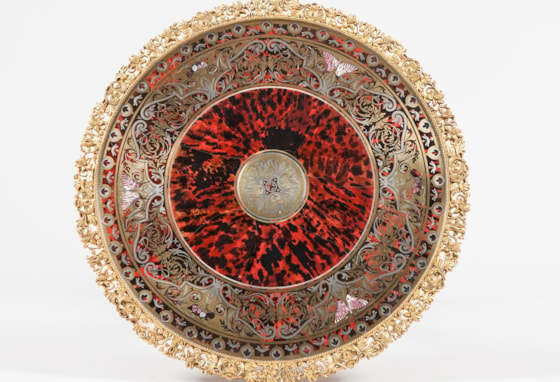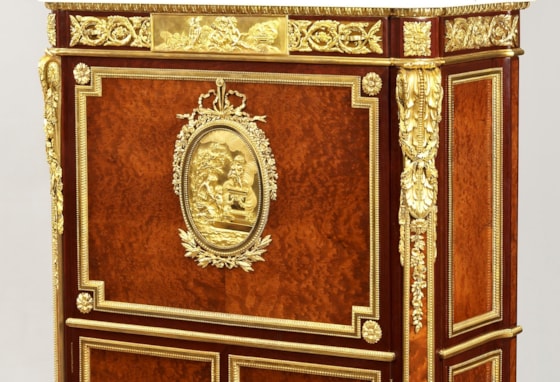Latest Stories
November 2025
British Antique Furniture: An Expert Guide to Value
November 2025
British Antique Furniture: An Expert Guide to ValueThe Investor’s Guide to British Cabinetmaking: A Lineage of Integrity
For the discerning collector, the true measure of an investment-grade antique is not found merely in its aesthetic appeal, but in its capacity for endurance. While beauty is subjective, value requires a verifiable foundation. The celebrated investment integrity of British cabinetmaking, particularly within the 18th-century sphere, is not a matter of chance. It is the direct result of a unique historical lineage that established a tangible framework for authenticity and quality, transforming fine furniture into a stable verifiable asset class.
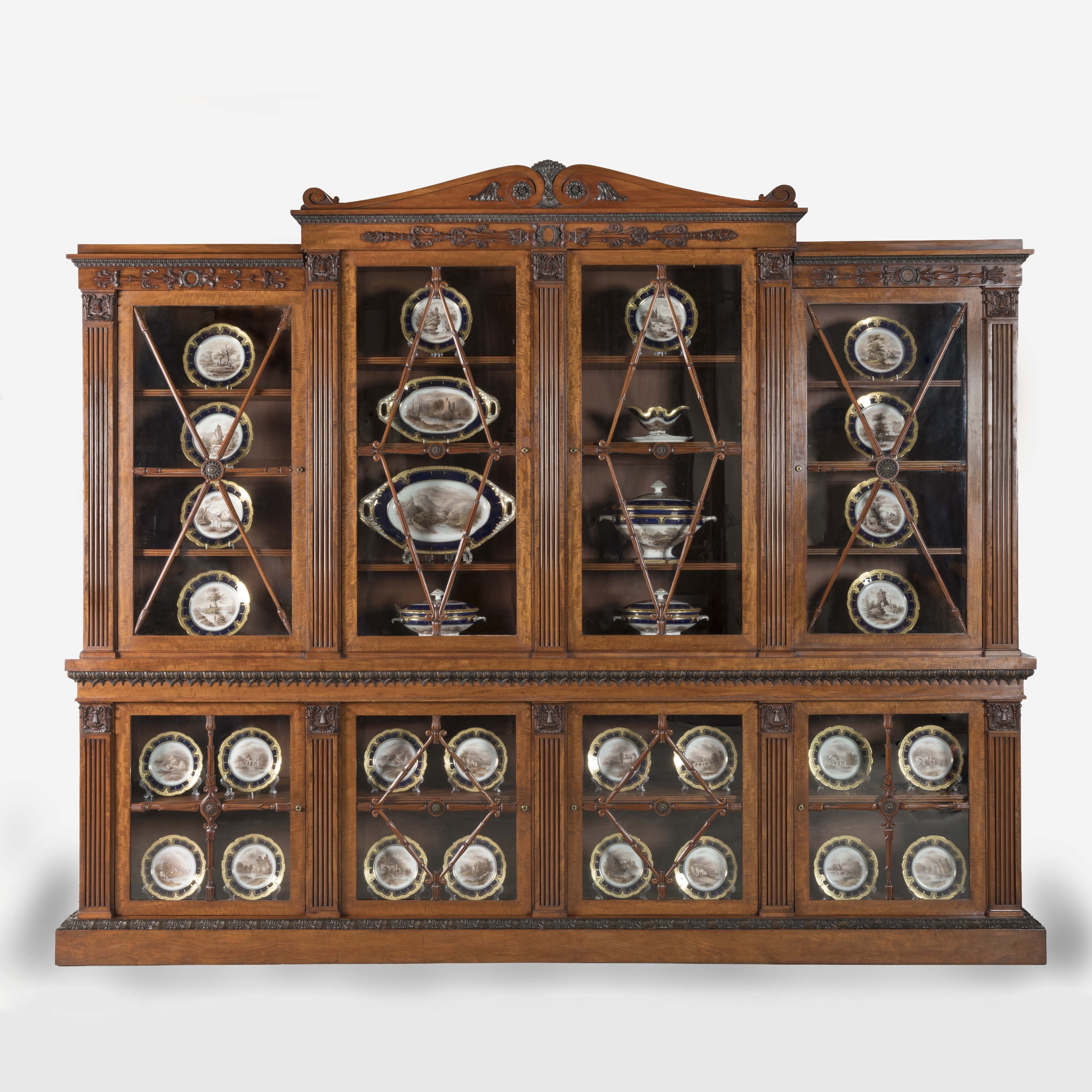
A Regency Mahogany Four Door Bookcase (ref. 10218), circa 1815, with Butchoff Antiques. Furniture Highlight at Treasure House, London, 2025.
This unparalleled lineage rests on three distinct pillars:
- The Codification of Style: The seminal role of published design standards that established verifiable construction and style benchmarks for the entire trade.
- Intellectual & Architectural Discipline: The imposition of rigorous aesthetic discipline, such as the archaeological Neo-Classicism of the Adam brothers, which ensured a timeless, architectural elegance.
- Institutional Accountability: A robust culture of archival record-keeping, perfected by dynastic firms like Gillow, which translates documented provenance directly into market premium and mitigates risk for the high-net-worth collector.
The 18th-Century 'Blueprints' of Value
That golden lineage begins with the master who first codified it. The investment integrity of 18th-century Georgian furniture is inextricably linked to the work and intellectual legacy of Thomas Chippendale. His unique position in the market stems not just from his mastery as a craftsman, but from his crucial role as a publisher who standardised and disseminated the aesthetic language of luxury furniture. The 1754 publication of The Gentleman and Cabinet-Maker's Director was a pivotal moment; it was far more than a style guide, it codified an entire design canon, making it the bedrock upon which the investment stability of the period rests.

Frontispiece of Thomas Chippendale's Director of 1754 in the collection of the Metropolitan Museum of Art, New York.
This work transformed the craft by providing a "widely accessible benchmark for quality and style," encompassing the three dominant tastes of the time: the intricate Rococo, the Gothic, and the Chinese. The numerous engraved plates established a "verifiable pedigree" for new commissions. For the modern collector and Georgian furniture specialist, this published canon serves as a crucial, objective tool for authentication. It allows a piece to be measured against a definitive historical standard, defining what constitutes "pure" 18th-century English design. This benchmark is essential because, unlike later institutional houses, Thomas Chippendale rarely stamped his furniture. Therefore, provenance becomes paramount. The Director is the key to unlocking it, either through direct documentary links, like an invoice referencing a specific plate, or through technical fidelity. An unsigned piece must demonstrate the superior execution, precise carving, and high-quality timber implied by the Director's sophisticated designs to confirm its pedigree. The Director thus serves as the single most important document in the 18th-century market, providing the definitive framework required to benchmark the design pedigree and investment integrity of furniture from this era.
If Chippendale defined the technical apex of the trade, the architects Robert and James Adam established its intellectual framework. The sustained market valuation of high-end Georgian furniture owes an enormous debt to their rigorous imposition of Neo-Classical integrity. Functioning as architects and designers rather than cabinetmakers, the Adam brothers championed a "total design concept". In their vision, furniture was not an isolated object; it was an integral, subordinate part of a unified interior scheme, designed to be in perfect harmony with the wall treatments, ceiling plasterwork, and chimneypiece.
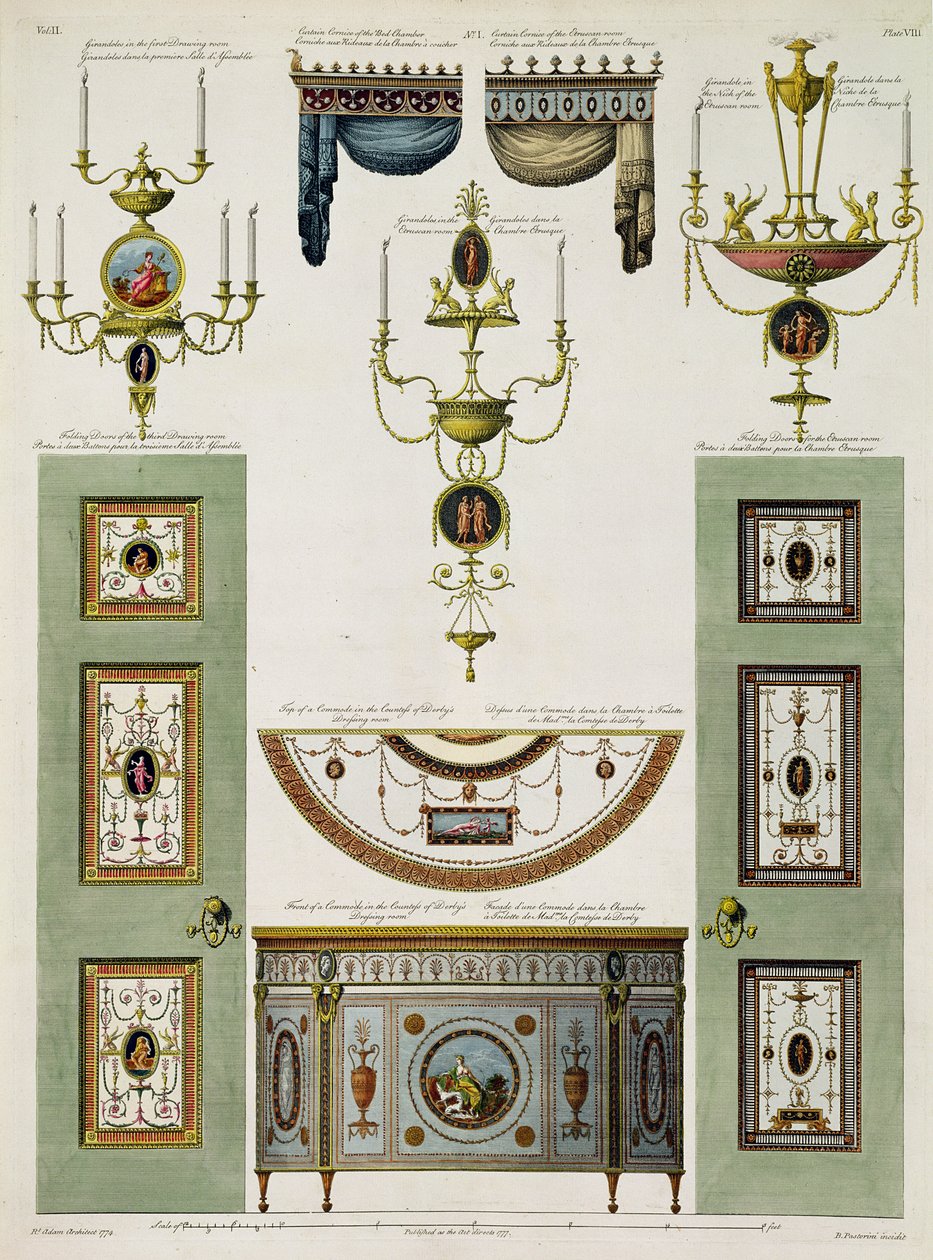
Adam Style showing the 'total design concept' championed by the brothers during the 18th century.
This unity was achieved through a scholarly "archaeological rigor", derived from their extensive studies of classical antiquity, including the ruins of Diocletian's Palace. They meticulously incorporated Roman and Greek motifs such as vases, urns, sphinxes, and patarae into their furniture designs. This architectural discipline resulted in pieces characterised by slenderness, symmetry, and delicate ornamentation, shifting the technical focus from deep carving to exquisite marquetry and contrasting veneers, such as satinwood against mahogany. This scholarly approach directly translates into enduring investment value. Because the Adam style is predicated on the timeless classical principles of harmony and balance, it possesses a profound "aesthetic longevity". It inherently "resists the cyclical devaluation that affects pieces tied to transient fashions," making an Adam-period piece a universally esteemed and timeless asset. They set the blueprint for a century of British taste, establishing the lingua franca that masters like Hepplewhite and Sheraton would later adopt.
The Institutional Guarantee: Provenance as Premium
Where the individual genius of 18th-century masters defined the blueprint for value, the 19th century perfected the model for guaranteeing it. For the risk-averse collector, this shift toward institutional accountability is the most critical factor in securing a long-term, blue-chip asset.
The firm of Gillow of Lancaster and London represents the pinnacle of this movement. Their high market valuation is predicated on one crucial factor: archival accountability. Unlike relying on subjective connoisseurship for attribution, a piece of Gillow furniture provides verifiable provenance through one of the most extensive commercial archives in history. The meticulous maintenance of job books, estimate sketches, and client ledgers that spanned generations, offers modern collectors an unparalleled ability to trace a piece's history, original cost, and specifications with remarkable precision. This documentation is the ultimate guarantee of investment integrity. It "translates historical paper trails directly into financial assurance," mitigating the primary risk of high-value antique acquisition: unproven authenticity. The presence of a "Gillow" stamp, often with a job number, acts as an explicit warranty of superior materials and construction, transforming the item from a mere attribution into a verified, dated, and provenanced object with a tangible market premium.
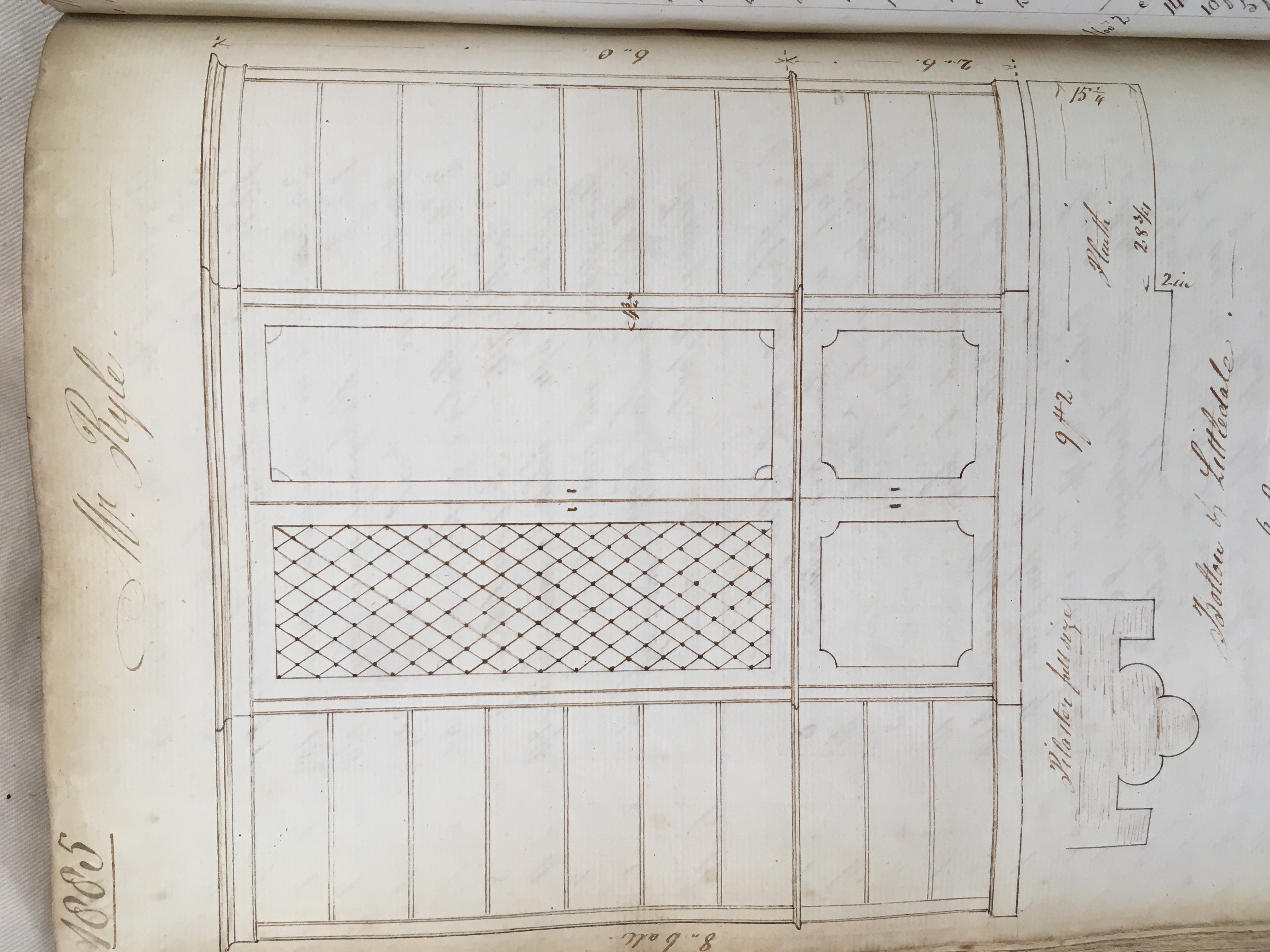
Design for a bookcase in the Gillow Archives, dated 1810. Photograph author's own.
This rigorous model of quality control and documentation was not an isolated practice; it became a national standard adopted by the great institutional houses of the Victorian era. As the 19th century ushered in the need for "mass-customisation," firms such as Holland & Sons and Hampton & Sons successfully navigated the integration of industrial scale without sacrificing prestige. Their primary strength lay in the comprehensive capacity to undertake vast, complex interior schemes for the aristocracy, institutional buildings, and the Royal Family. Managing these large-scale commissions required "strict internal quality control measures" to maintain consistency, a process that provides a valuable layer of "investment assurance" to the modern collector. Like Gillow, these firms maintained "detailed archives of commissions," providing a verifiable paper trail that reduces ambiguity and supports an asset's valuation.
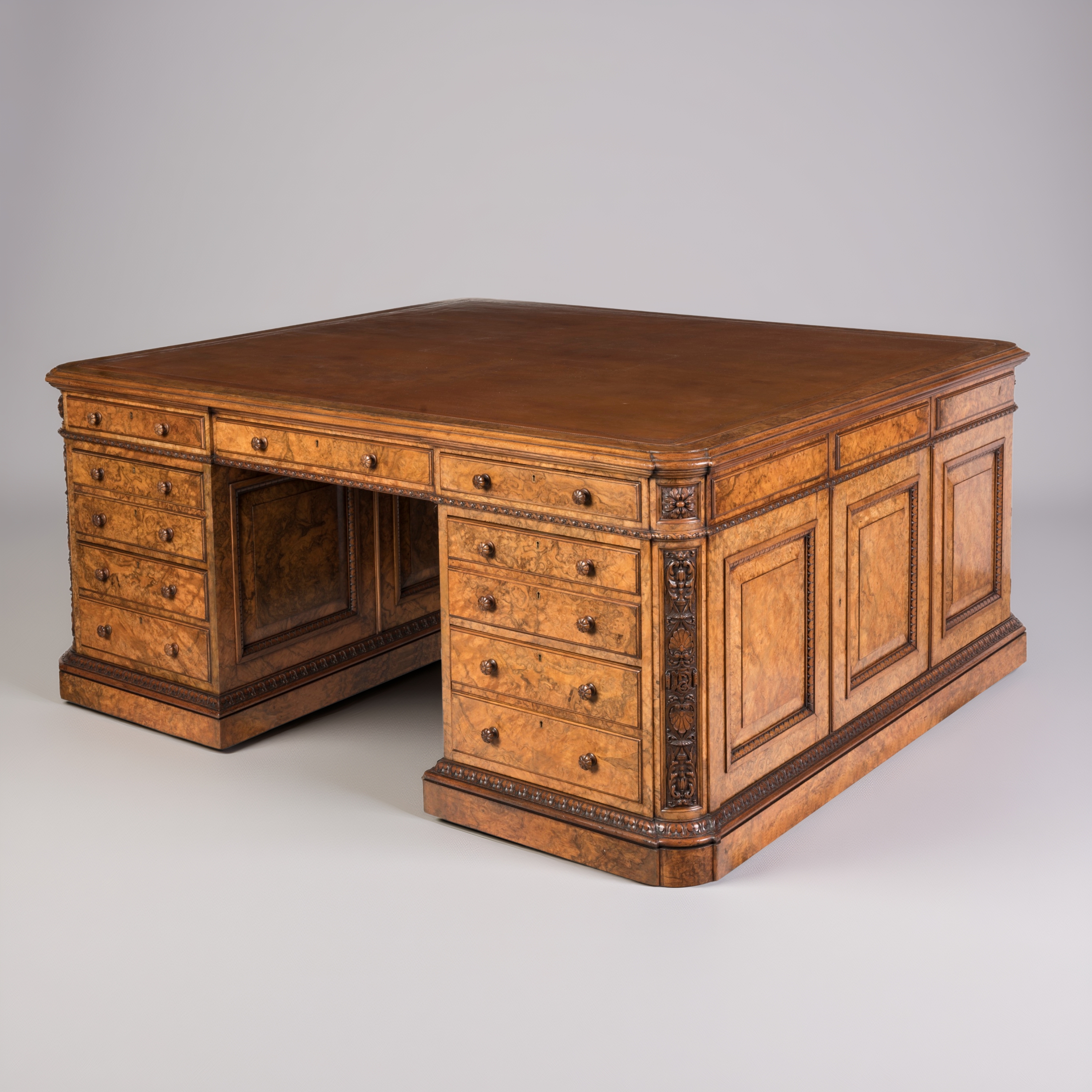
A Substantial Walnut Partners' Desk by Holland & Sons, circa 1865, with Butchoff Antiques (ref. 10145).
This commitment to accountability extended far beyond the capital. Significant regional firms, such as Lamb of Manchester, demonstrated that this institutional integrity was a national characteristic. Adhering to the same rigorous standards, Lamb of Manchester rivaled its London counterparts, securing major commissions to furnish the homes and civic buildings of the new industrial elite. These pieces are often tied to significant "local provenance" and bear the firm's stamps or labels, providing "unambiguous evidence of origin". The success of these Victorian furniture dealers, both metropolitan and regional, proves that the British blue-chip model is defined by a consistent, national capacity to deliver verifiable quality and documented history, offering the collector a uniquely stable and reliable asset class.
Hallmarks of Authenticity: What Collectors Must Look For
A piece's pedigree is written in its material and construction. For the serious collector, understanding these physical "hallmarks" is the most reliable method of antique authentication, providing tangible proof of quality that transcends stylistic opinion.
The high investment value of British furniture is fundamentally rooted in a "Material Purity Thesis". This methodology prioritised structural integrity and superior primary materials over the Continental, particularly French, emphasis on elaborate surface decoration. British cabinetmakers of the Golden Age deliberately selected timbers that offered stability, density, and aesthetic depth, ensuring the primary value lay in the substance of the wood itself.
Mahogany was the definitive timber of the Georgian and Regency periods. Its exceptional density, resistance to warping, and deep, rich figure made it the ideal medium for both sculptural carving and enduring construction. The presence of high-quality, old-growth mahogany is a primary marker of high-value work. In the late 18th century, satinwood emerged as the preferred veneer for its pale, shimmering surface, ideal for the delicate inlay favored by masters like Adam and Sheraton.
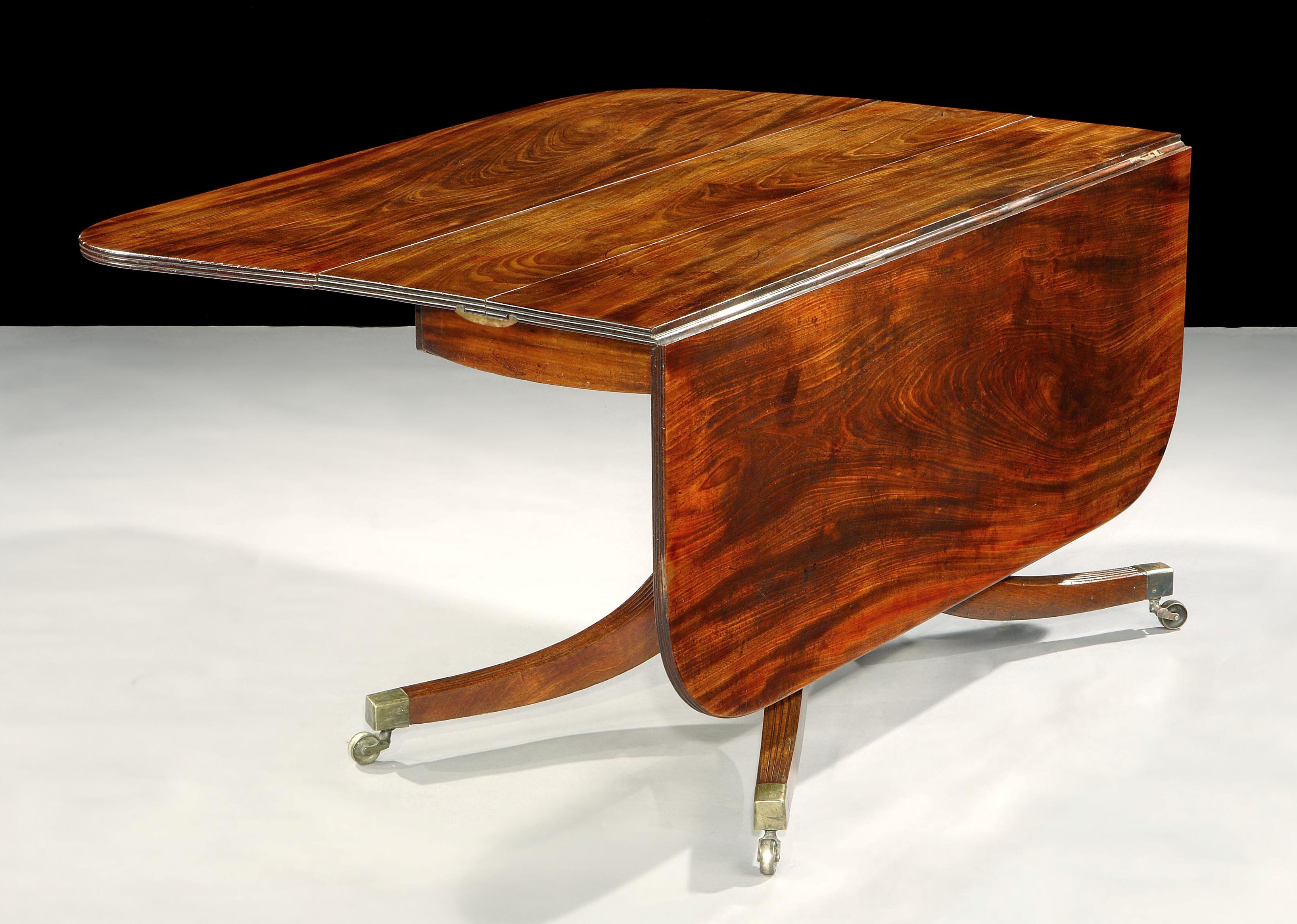
Regency Period Mahogany Dining Table by William Pocock of Covent Garden, circa 1810, previously with Butchoff Antiques.
This focus on superior timber was matched by a commitment to refined British joinery. While French ébénisterie often concealed a simpler carcass beneath complex veneers and gilt-bronze ormolu mounts, the British tradition celebrated unseen structural excellence. Precision joinery, such as meticulous dovetailing in drawer construction or robust mortise and tenon joints, served as the primary technical signature. For a connoisseur, examining the tightness and accuracy of these joints is often a more reliable indicator of 18th-century English craftsmanship than the surface decoration alone. This methodology ensured the investment value rested on the enduring quality of its structure, guaranteeing a longevity that a piece valued primarily for its delicate surface mounts could not.
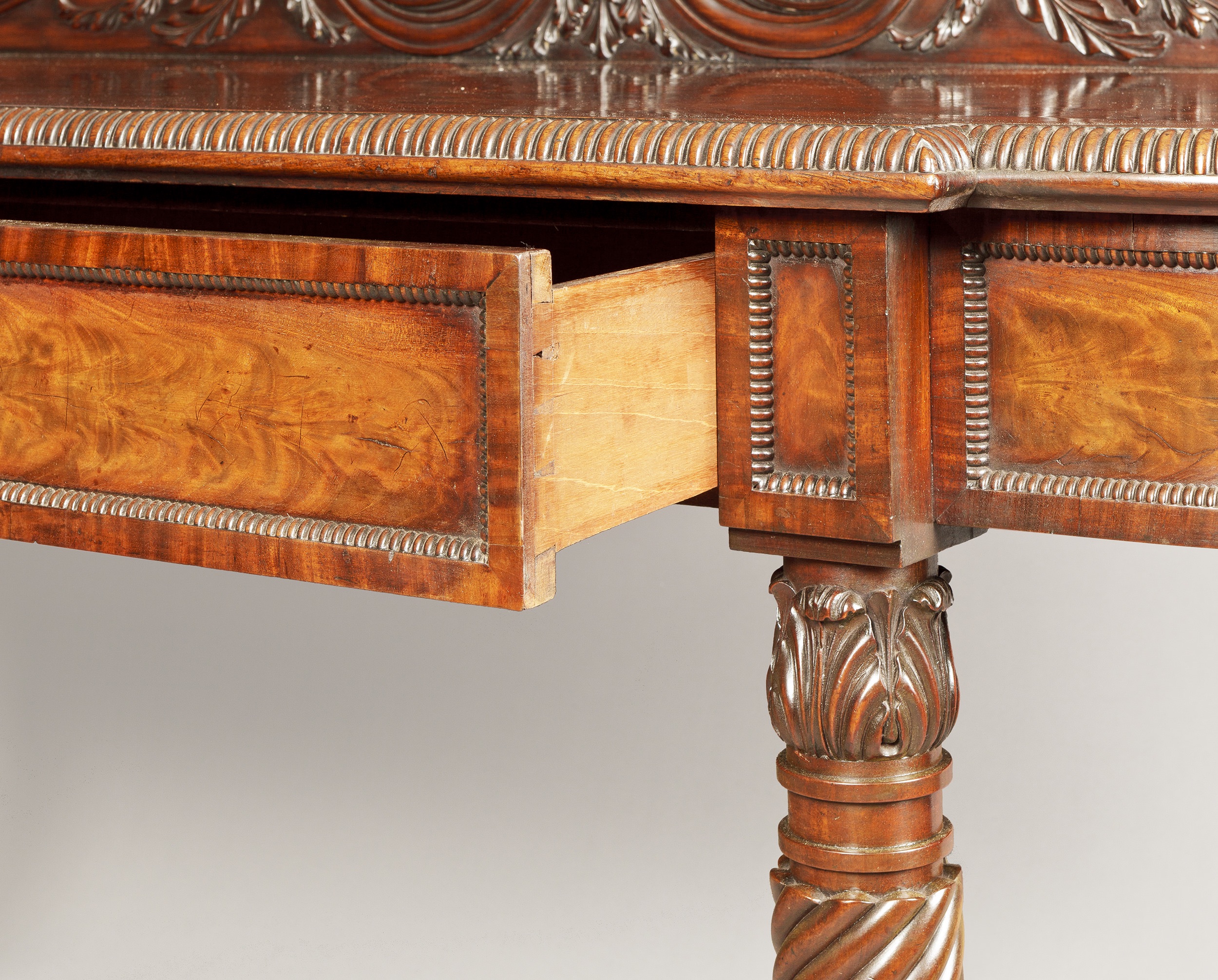
Detail of Georgian Serving Table, circa 1820, with Butchoff Antiques (ref. 7819), showing dovetail construction of the drawer.
This principle of verifiable, technical quality is perfectly illustrated by the specialist firm Howard & Sons. While other firms focused on cabinetry, Howard & Sons carved out a niche focused on the pinnacle of domestic comfort: functional excellence and bespoke upholstery connoisseurship. For collectors today, their work is valued for its unique and systematic use of verifiable markings that provide a "technical guarantee of provenance".
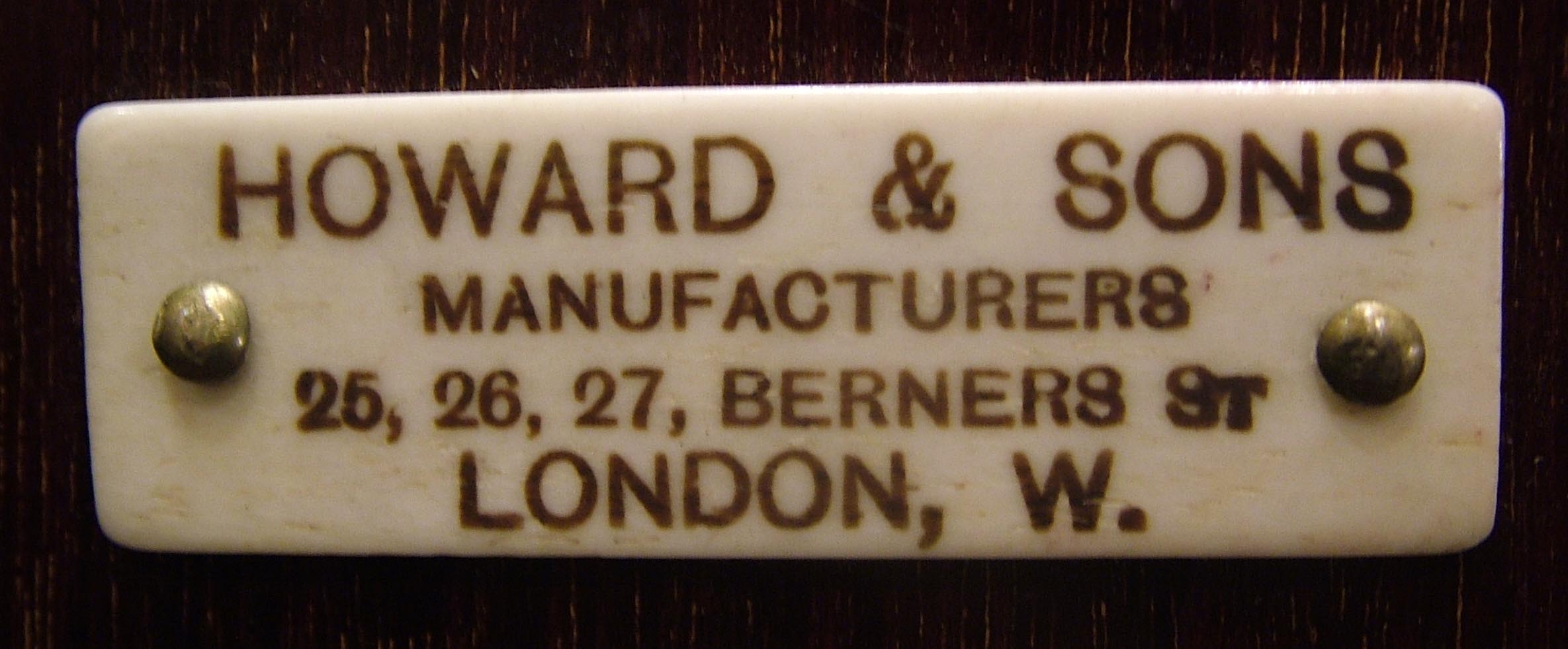
Label used by Howard & Sons. Photograph author's own.
Unlike much antique seating, which relies on stylistic attribution, Howard & Sons pieces can be definitively identified. The firm implemented a meticulous system of numbering and stamping its frames. Pieces often bear specific frame markings, serial numbers, and even date codes. This practice is crucial for authentication, as the stamps and numbers can be cross-referenced with surviving records, providing a level of certainty rarely available for upholstered furniture. The firm is particularly noted for its distinctive brass castors, which often carry the "HOWARD & SONS LONDON" stamp. The quality and wear on these original castors are a primary point of inspection for authenticators. This rigorous system of physical antique stamps and serials effectively reduces the subjectivity of valuation, transforming a Howard & Sons chair or sofa into a transparent, secure asset with verifiable authenticity.
This unbroken thread of intellectual and technical rigor connects the entire Golden Age of British design. The "investment purity" of the Regency design period, for instance, stems directly from its steadfast adherence to the classical standards established by earlier architectural masters.
The lineage begins with William Kent in the early 18th century. As a central figure in the English Palladian movement, Kent established the "architectural imperative" in furniture design. His pieces, which were often monumental, sculptural, and densely carved, were conceived as intrinsic components of the grand Palladian interiors he designed. This work established the foundational principle of British furniture as a serious, architecturally-derived collectible.
This tradition was later perfected by the intellectual apex of the Regency style, Thomas Hope. At the turn of the 19th century, Hope’s "scholarly rigor" provided the necessary discipline to maintain the integrity of British Neo-Classicism. His seminal 1807 work, Household Furniture and Interior Decoration, codified an academic approach based on meticulous studies of Greek, Roman, and Egyptian antiquity. This resulted in a refined form of Neo-Classicism, often termed Greek Revival or Egyptian Revival. Hope’s fusion of scholarly accuracy with grand, clean lines, seen in forms like the klismos chair or the use of lion monopodia, anchored the valuation of these pieces in the "enduring quality of educated taste". From Kent’s Palladianism to Hope’s antiquarianism, this continuous thread of architectural discipline ensured that British furniture remained rooted in timeless classical principles, a critical factor for capital preservation.
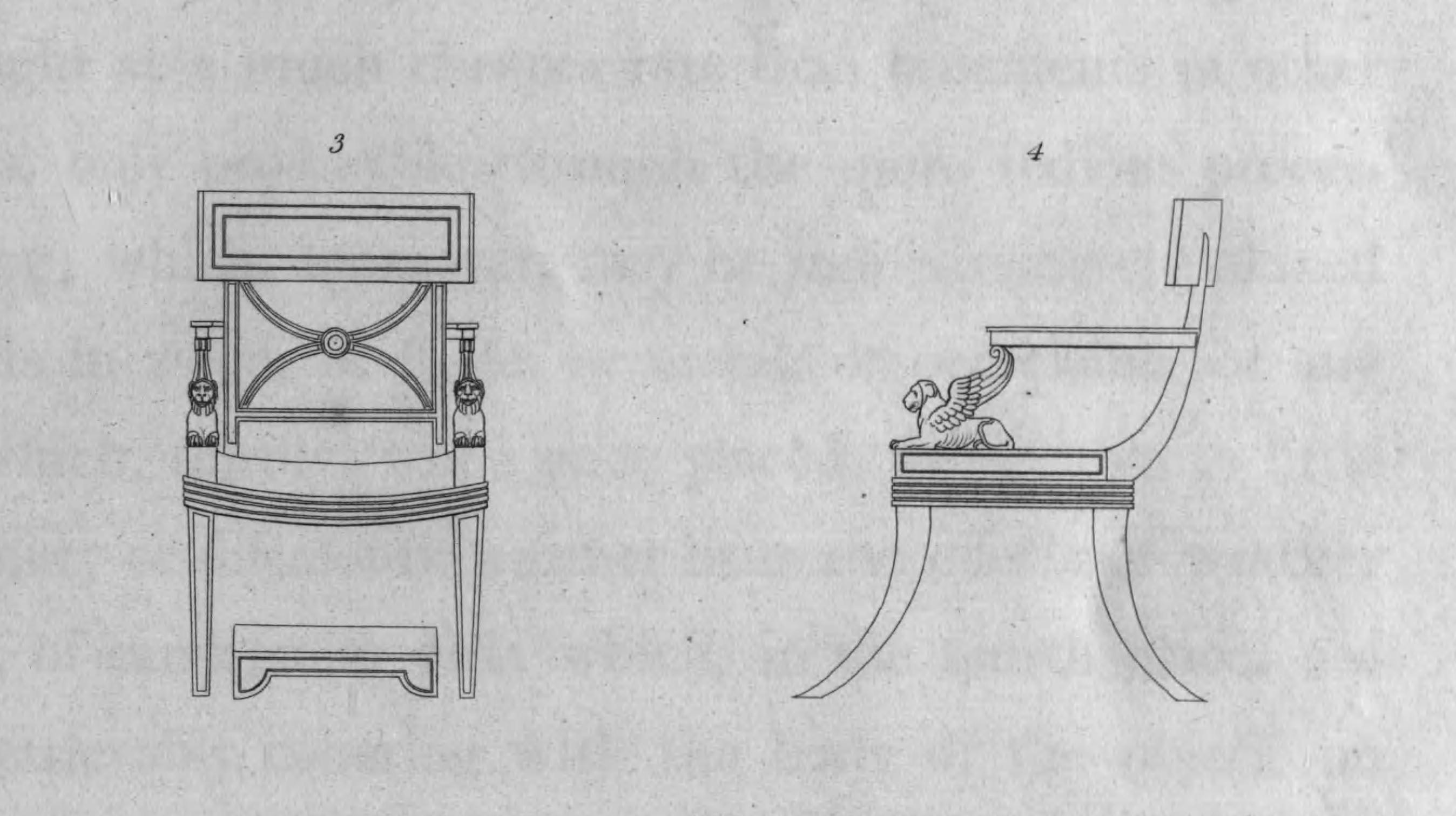
Design for a Klismos type armchair by Thomas Hope, published in 1807.
The "blue-chip" status of British cabinetmaking is, therefore, not a historical accident. It is the direct result of a traceable lineage: the published standards that created a verifiable design canon; the rigorous architectural discipline that imposed a scholarly, classical integrity to ensure timeless aesthetic appeal; the institutional accountability of firms like Gillow, whose meticulous archives provide verifiable proof that mitigates risk for the collector; and a foundational commitment to material integrity, prioritising superior timbers and structural joinery over simple surface decoration.
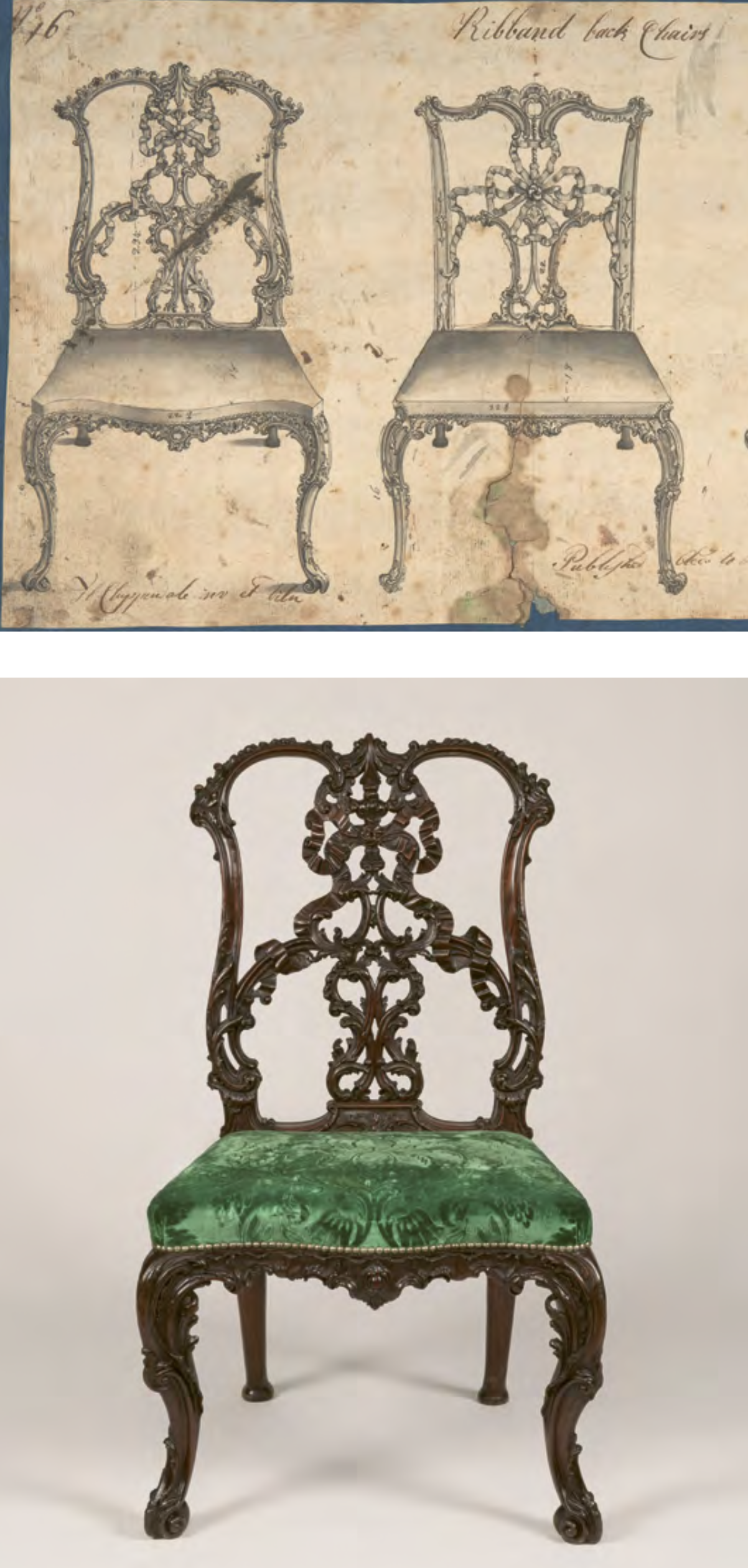
This unwavering commitment to integrity and provenance is the guiding principle of the Butchoff Antiques collection. Our passion is rooted in the "perennial pursuit to buy & sell outstanding items" that exemplify this history. We invite you to explore our curated antiques, each one expertly acquired with the deep connoisseurship this distinguished lineage demands. When you purchase from Butchoff, "you can do so with confidence", securing a verifiable asset of enduring quality, character, and style.
Writen by Rainier Schraepen
A Comprehensive Guide
The pursuit of antique lights & lamp collecting represents one of the most sophisticated and nuanced areas of decorative arts connoisseurship, combining elements of technological innovation, artistic excellence, and historical significance.
Throughout the centuries, the evolution of artificial illumination has paralleled humanity's greatest advances, from the humble oil lamps of antiquity to the revolutionary artistic achievements of the late Victorian period antiques era and beyond. This progression has left us with an extraordinary legacy of craftsmanship and design that continues to captivate serious collectors and scholars alike.
The study of antique lighting encompasses far more than mere functional objects; these pieces serve as profound markers of both technological advancement and decorative artistry. From the exquisite bronze work of French Empire period bouillotte lamps to the revolutionary artistic achievements of American studios like Tiffany and Handel, each era has contributed its unique aesthetic vocabulary to the canon of lighting design.

A pair of antique Asian cloissonné enamel lamps at Butchoff Antiques, with a large English silvered banqueting lamp in the mirror reflection.
The sophisticated collector must develop an intimate understanding of these historical periods, their distinctive characteristics, and the technical innovations that defined them. Authentication represents perhaps the most crucial aspect of antique lamp collecting, requiring a comprehensive knowledge of period-specific manufacturing techniques, materials, and artistic signatures. The ability to distinguish original patination from modern finishing, recognize authentic period electrical components, and identify legitimate maker's marks demands years of dedicated study and hands-on experience.
This expertise becomes particularly vital when evaluating pieces from highly sought-after manufacturers, where the difference between an original work and a later reproduction can represent significant variations in both historical importance and market value.
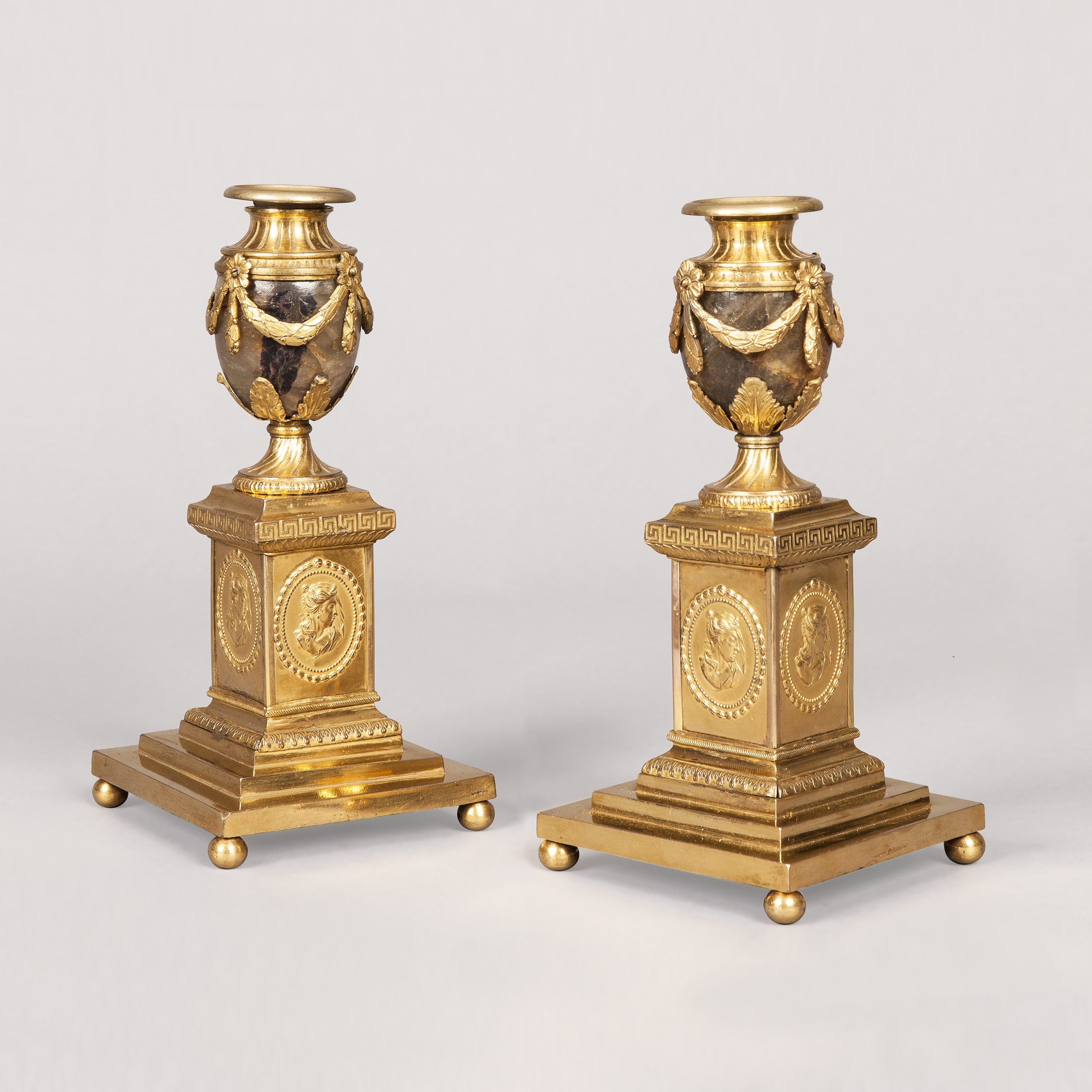
A Pair of 'Cleopatra' Candle Vases made by Matthew Boulton, c.1770, sold by Butchoff Antiques
As we delve deeper into the fascinating world of antique lighting, we shall explore the distinctive characteristics of major design movements, from the ornate complexity of Victorian Rococo Revival to the geometric precision of Art Deco, examining how each period's philosophical and artistic principles manifested in illumination design. This knowledge forms the essential foundation for any serious collector or enthusiast seeking to navigate the sophisticated market for fine antique lighting. The Georgian and Regency periods represent a golden age in British decorative lighting, marked by exceptional craftsmanship and innovative design that reflected the refined sensibilities of 18th and early 19th century aristocratic life.
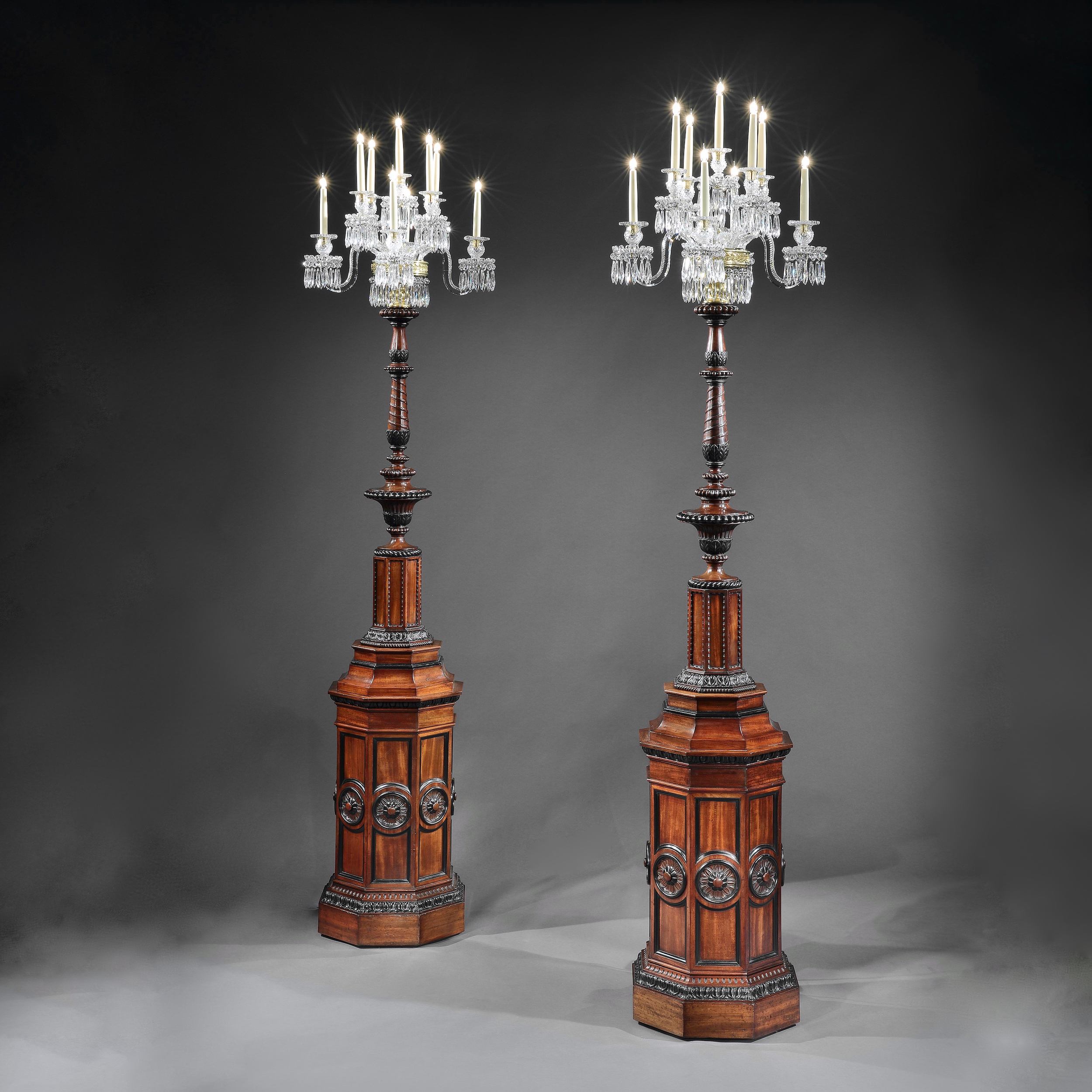
Masterpieces of Georgian lighting, these floor-standing candelabra with glass attributed to Hancock & Rixon were made circa 1825. Butchoff Antiques
During this era, master silversmiths and bronziers created extraordinary pieces that merged functionality with artistic excellence, establishing standards of quality that continue to command attention from discerning collectors today. The earliest Georgian lighting solutions predominantly featured silver and brass candelabra, with notable London workshops such as Paul de Lamerie and Matthew Boulton producing exemplary pieces characterized by their classical proportions and sophisticated embellishments. These masterworks often incorporated neoclassical elements, including acanthus leaves, Greek key patterns, and elegant fluting, while maintaining the structural integrity necessary for practical illumination. The introduction of Argand-style oil lamps in the 1780s marked a significant technological advancement, allowing for brighter, more controlled illumination while presenting new opportunities for artistic expression in brass and bronze.
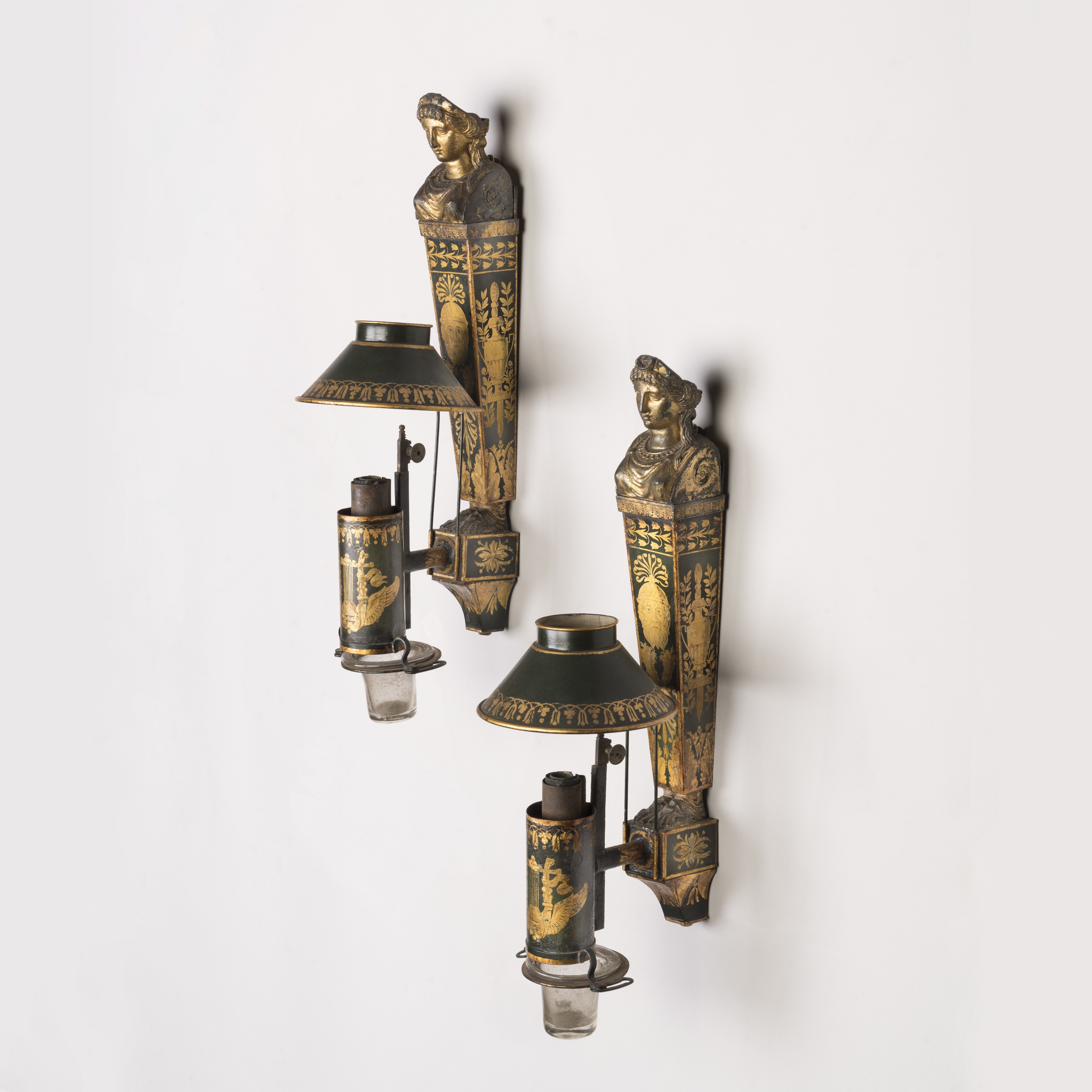
Related to the Argand Lamp, the "Quinquet" lamp, after Antoine-Arnoult Quinquet, a pharmacist in Paris, introduced a much-improved version with more brightness. Its success made it the most popular lamp of the early 19th century, until it was replaced by Kerosene lamps around 1850. Sold by Butchoff Antiques
The transition into the Regency period saw an evolution in both form and function, with craftsmen such as Benjamin Vulliamy introducing more elaborate decorative elements inspired by Egyptian and Oriental motifs. These pieces frequently featured ormolu mounts, engine-turned columns, and cut-glass hurricanes that created spectacular light effects. Authentication of pieces from this period relies heavily on proper hallmarking, particularly in silver examples, while brass and bronze pieces often bear distinctive maker's marks or workshop stamps. The most sought-after examples typically showcase exceptional chasing and casting quality, with original gilding or patination intact.
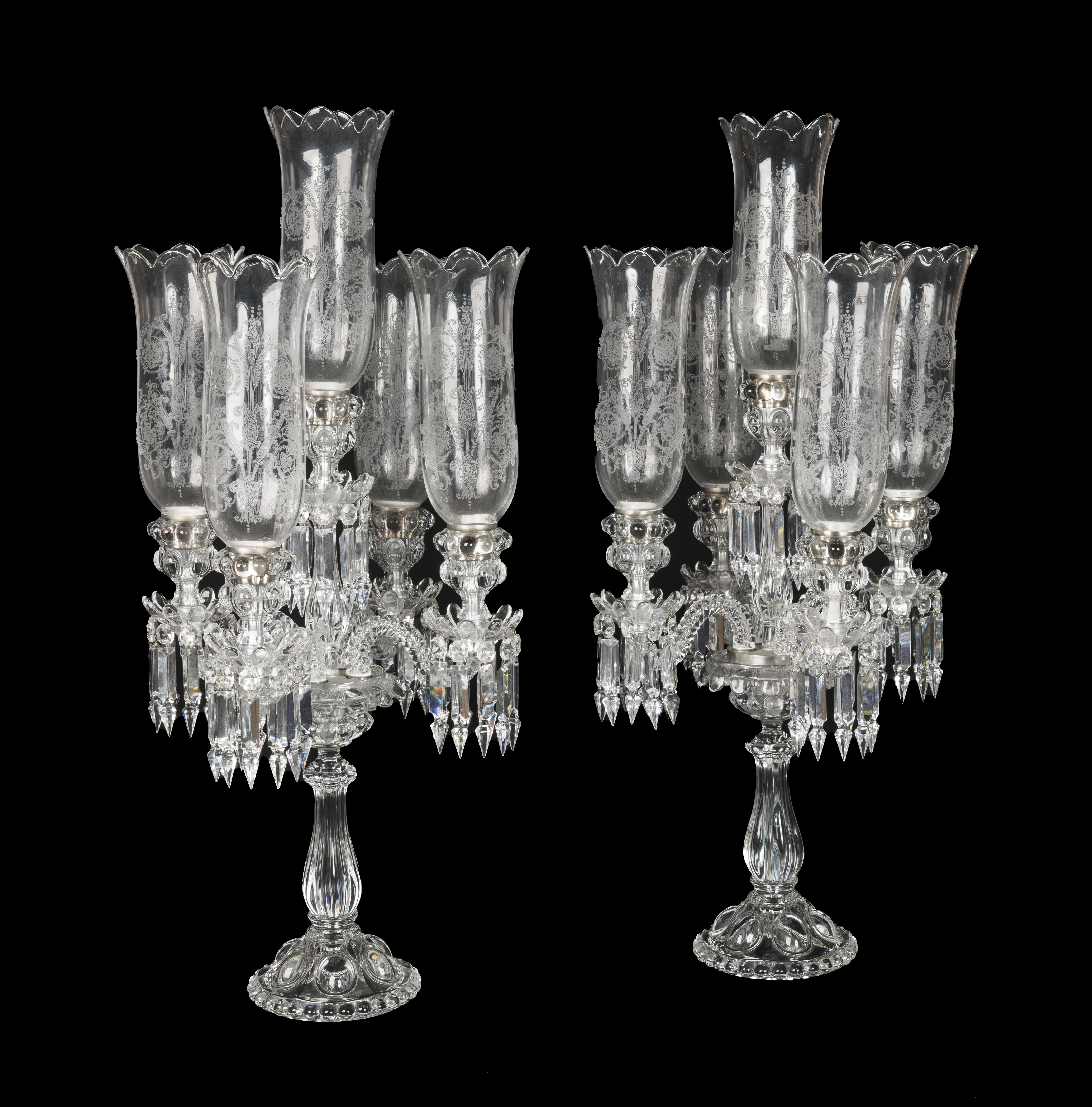
A complete pair of candelabra with hurricane shades, the bases stamped Baccarat & each shade with etched signature of Baccarat. Butchoff Antiques.
Today's market particularly values complete sets of Georgian candelabra and early Regency oil lamps that retain their original finish and demonstrate documented provenance. Pieces bearing the marks of renowned workshops, especially those with aristocratic commissioned histories, command premium prices at auction and through specialized dealers. The Victorian era heralded unprecedented innovation in domestic lighting, fundamentally transforming both the technical capabilities and aesthetic sensibilities of British illumination. The introduction of gas lighting in the 1820s sparked a revolution in lamp design, with manufacturers such as Messenger & Sons of Birmingham and Faraday & Son of London creating sophisticated brass and bronze gas fixtures that merged classical motifs with modern engineering.
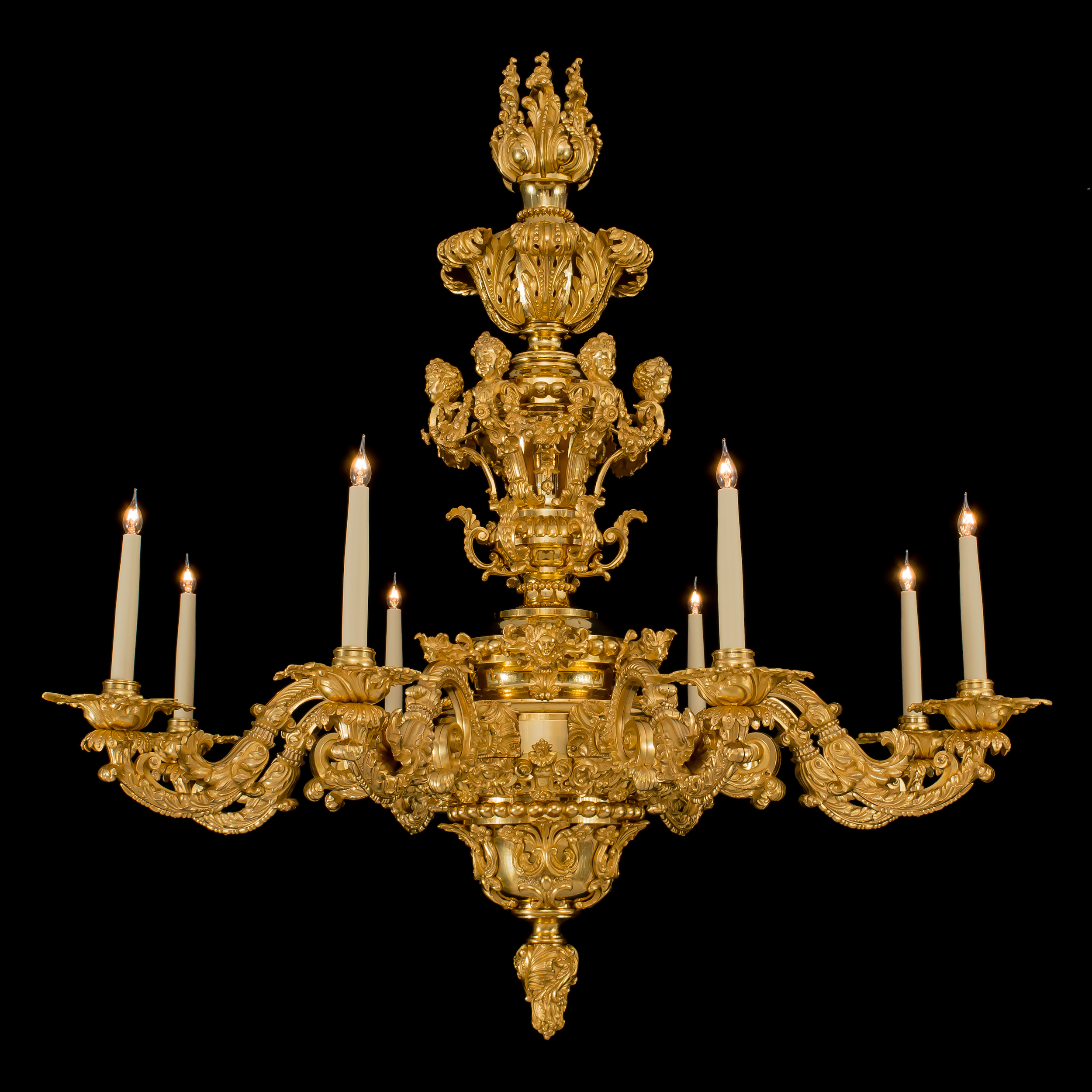
Initially designed for real candles and lowered with the help of a pulley, this gilt bronze chandelier by Messenger & Phipson, c.1825, is now fully electrified. Butchoff Antiques
The parallel evolution of oil lamp mechanisms during this period produced remarkable advances in functionality and safety. The development of the duplex burner by George Hinks in 1865 represented a significant breakthrough, allowing for brighter, more controlled illumination while maintaining the decorative elegance demanded by Victorian sensibilities. This innovation was quickly adopted by prestigious manufacturers including Hinks & Sons of Birmingham and Young & Sons of Edinburgh, who incorporated the technology into increasingly ornate designs featuring cut glass fonts and elaborate metalwork. Victorian lamp design drew inspiration from an eclectic array of historical styles, reflecting the era's fascination with revivalist aesthetics. Gothic Revival elements appeared in ecclesiastical-inspired brass work, while Rococo flourishes adorned drawing room pieces, particularly in the scrolling foliate patterns favored by firms such as F&C Osler.
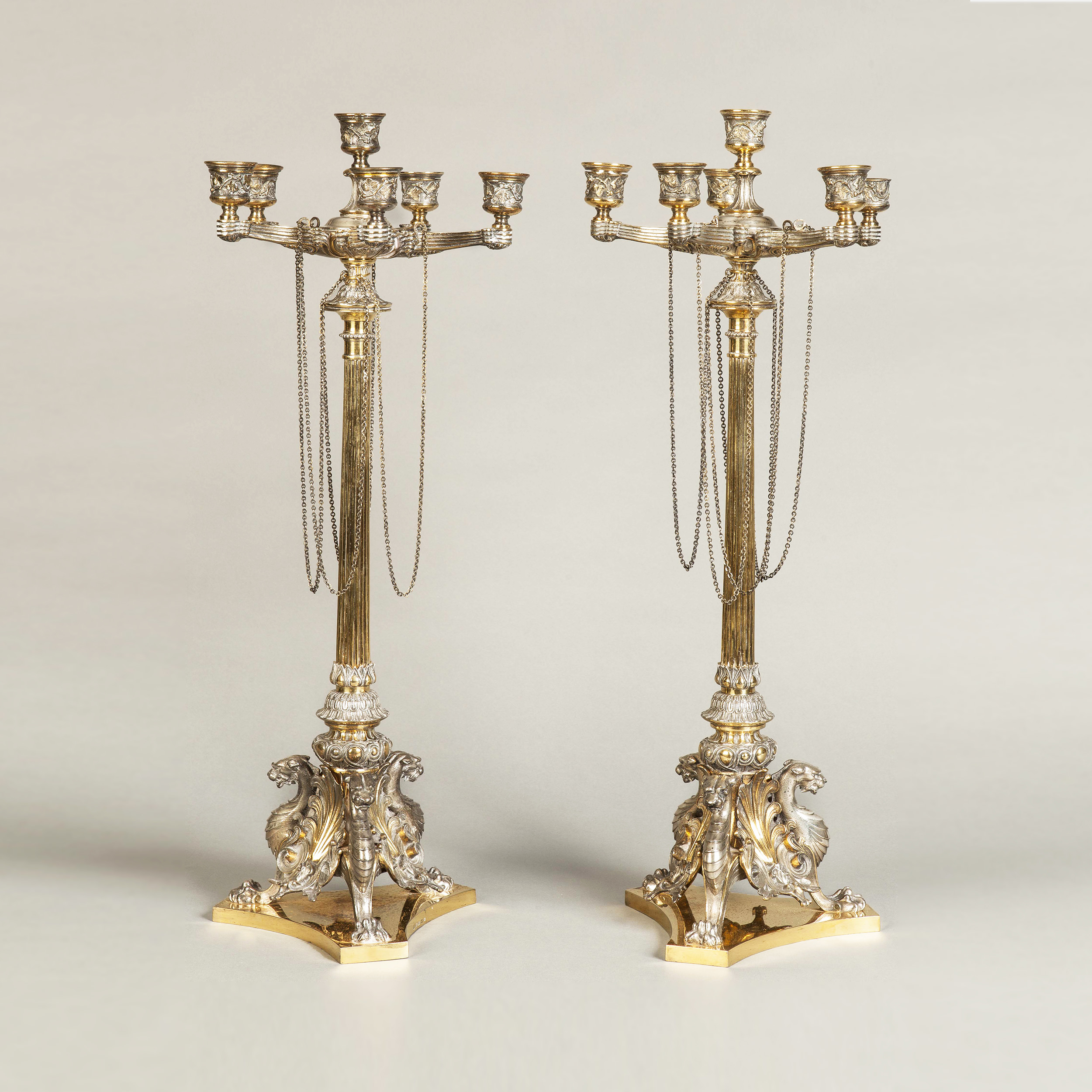
A pair of gothic-inspired silver plated and parcel gilt candelabra by Elkington & Co, c.1865. Butchoff Antiques.
The introduction of new manufacturing techniques, including improved lost-wax casting and mechanical pressing of glass components, allowed for more intricate detailing while maintaining the robust construction that characterizes genuine period pieces. The most distinguished Victorian manufacturers left distinctive markers of authenticity, from Messenger's characteristic wing nut designs to Osler's distinctive acid-etched signatures. These identifying features, combined with period-specific construction methods such as hand-cut threads and individually crafted burner mechanisms, provide crucial authentication points for modern collectors seeking genuine Victorian lighting specimens.
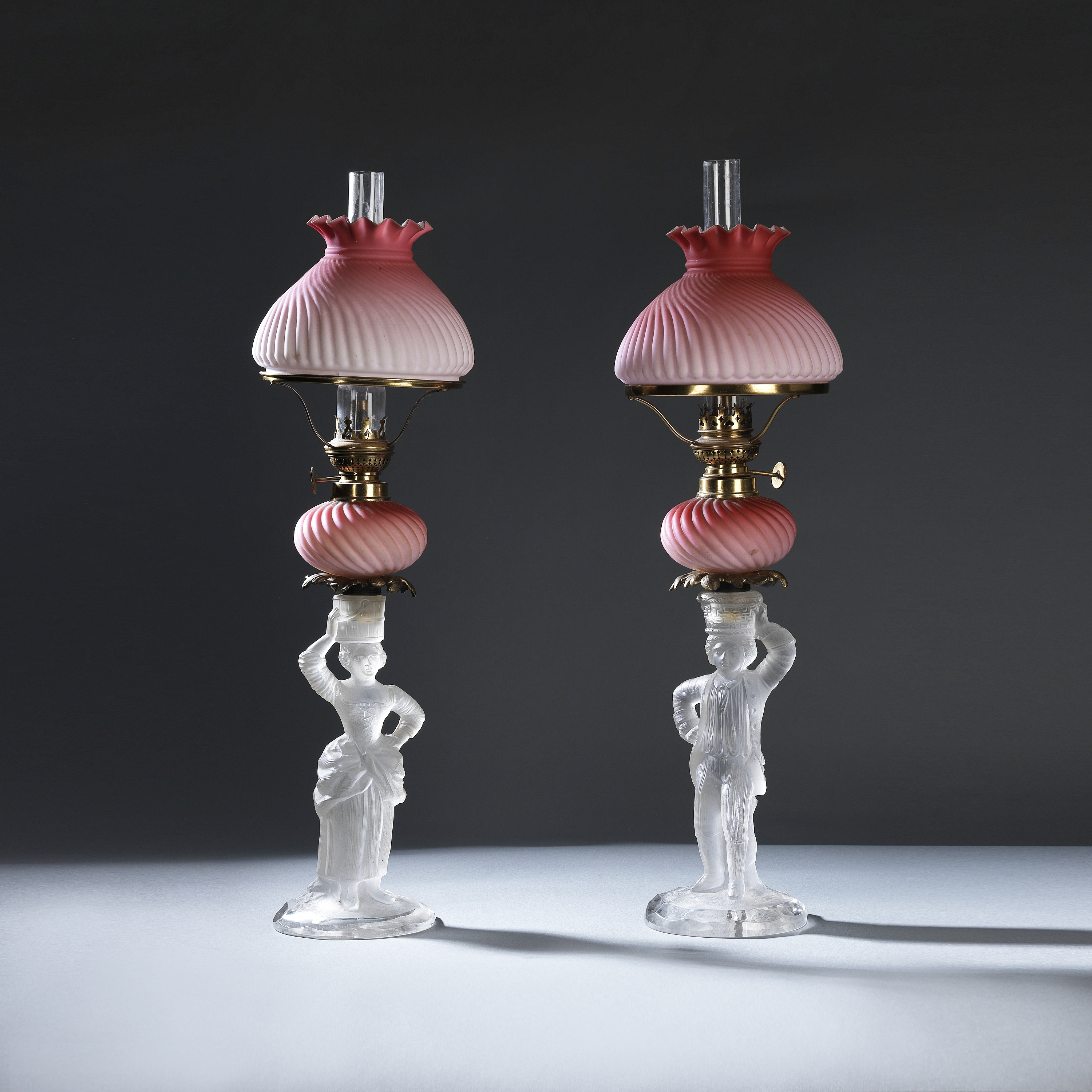
The 'Kosmos' burner was patented in the UK in 1865, by Wilde & Wessel of Berlin. The company was taken over in 1899 by Messrs Brokleman, Jager et Cie, at which point the winder mechanisms were marked 'Kosmos Brenner'. These burners were sold wholesale on a worldwide basis, and were still being manufactured up until 1974. Butchoff Antiques.
The dawn of the twentieth century ushered in revolutionary artistic movements that profoundly transformed decorative lighting design, with Art Nouveau and Art Deco establishing distinctly different approaches to lamp craftsmanship. The sinuous, nature-inspired forms of Art Nouveau found their ultimate expression in the works of Louis Comfort Tiffany, whose innovative use of opalescent glass and naturalistic themes created an entirely new vocabulary in lighting design. These celebrated pieces, particularly those featuring dragonfly motifs and flowering tree patterns, commanded extraordinary prices even in their own time, with documented sales to British nobility and industrial magnates through luxury retailers such as Liberty of London. The European interpretation of these movements, particularly in Britain, took a markedly different direction from their American counterparts. Notable British craftsmen such as W.A.S. Benson pioneered their own distinctive style, combining the flowing lines of Art Nouveau with a characteristically British restraint in ornamentation. Their works frequently featured sophisticated combinations of materials, including hand-hammered copper, brass with patinated finishes, and innovative glass treatments developed in conjunction with James Powell & Sons of Whitefriars.
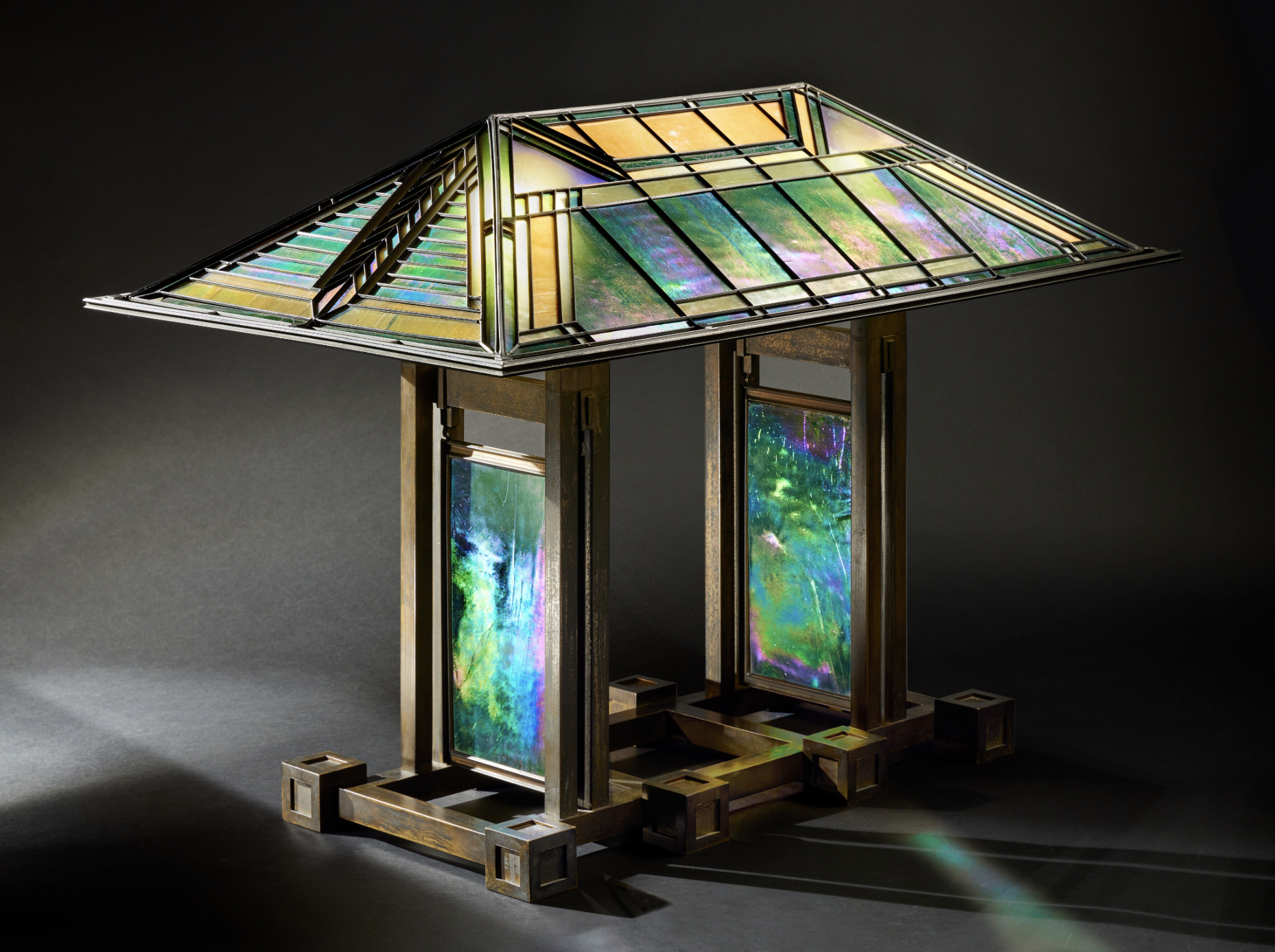
Designed by Frank Lloyd Wright, and made circa 1904 for the Thomas-Dana house in Illinois, this antique lamp broke the record for the designer & architect, achieving $7.5 million in 2025.
The transition to Art Deco in the 1920s brought a dramatic shift toward geometric precision and modern materials. British manufacturers such as Osler & Co of Birmingham embraced this new aesthetic while maintaining traditional craftsmanship standards, creating pieces that incorporated chrome-plated elements, stepped architectural forms, and innovative uses of cut and frosted glass. For contemporary collectors, authentication of pieces from this transformative period requires particular attention to period-appropriate materials and manufacturing techniques, with original electrical components and period-specific glass treatments serving as crucial indicators of authenticity. The market for these sophisticated examples of British craftsmanship continues to strengthen, with documented provenance and original condition commanding premium valuations at prestigious London auction houses. The enduring allure of antique lamps extends far beyond their decorative appeal, representing a fascinating confluence of artistic innovation, technological advancement, and cultural evolution. For the discerning collector, these illuminating artifacts offer both aesthetic pleasure and compelling investment potential, particularly as authenticated pieces from renowned manufacturers continue to appreciate in value. The preservation of these historical treasures demands a thorough understanding of proper care techniques, including specialized cleaning methods for delicate materials such as leaded glass and period-appropriate metalwork restoration approaches that maintain authenticity while ensuring structural integrity. The pursuit of antique lighting requires a methodical approach to authentication, ideally guided by established experts in the field. Professional verification services, such as those offered by respected institutions and certified appraisers, provide crucial documentation that enhances both the historical record and market value of significant pieces. The British antiques trade, with its centuries of expertise and rigorous standards, has consistently led the way in establishing authentication protocols that have become industry benchmarks. For collectors seeking to expand their knowledge, numerous scholarly resources offer invaluable insights into specific periods and makers. The archives of venerable British institutions, including the Victoria and Albert Museum and the Royal Collection, provide extensive documentation of historical lighting designs and manufacturing techniques. Contemporary collectors would do well to cultivate relationships with reputable dealers who maintain strong connections to these institutional resources while offering guidance on market trends and acquisition opportunities. The most successful collections invariably result from a combination of passionate interest, careful research, and expert consultation, ensuring that each acquisition contributes meaningfully to the preservation of our decorative arts heritage while providing sound investment value for future generations.
Written by Rainier Schraepen
It is very likely when someone thinks about English furniture, one would envision pieces which are finely crafted, brown in colour, and representing the epoch of comfort and grand English country houses – all characteristics that shape the Georgian period. This extensive period witnessed some of the greatest and most influential designers and furniture makers in England’s history, such as William Kent, Robert Adam, Thomas Chippendale, George Hepplewhite, and Thomas Sheraton.
Georgian furniture is not titled due to its physical characteristics, but the alignment of the reigns of four consecutive English Kings, fittingly all named ‘George’, spanning from 1714 to 1830. The early period was marked with England ruling the waters with ships in ports all over the world, trading for exotic goods such as spices, textiles, and woods and discovering new ornamentations for architecture and furniture design. An English banker who successfully backed such mercantile conquests built grand country house, Osterly Park. Decoration and furnishings by Thomas Chippendale and Robert Adam – the Andy Warhol’s of their time - decorated Osterly Park.
The supreme characteristic of Georgian furniture is the predominance of exotic hardwoods with striking textural grains, such as mahogany from Cuba, San Domingo, South America or the West Indies; rosewood from Brazil, Honduras, and India; and satinwood from the West Indies. A striking example of the romaticization of exotic woods is this unusual Circular Table (ref. 6767) inlaid with eight different specimen woods on mahogany ground creating an eye-catching vortex design. Woods so rare that our timbers expert, Dr Adam Bowett, could not identify them all.

Ref. 6767, A Remarkable Late Georgian Circular Table, circa 1825. Butchoff Antiques, London.
The ornamentation of Georgian furniture is characteristically tasteful, inlaid with contrasting woods or gilded in gold leaf, and ornamentation of carvings with architectural motifs inspired by Classical Greece and China. A secretaire bookcase (ref. 7139), attributed to John McLean of London, incorporates the finest qualities of Georgian furniture. The bookcase rises from compressed ball brass feet and is constructed from a well-figured goncalo alves timer which is tastefully accented with gilt brass accents inspired by Classical Antiquity.
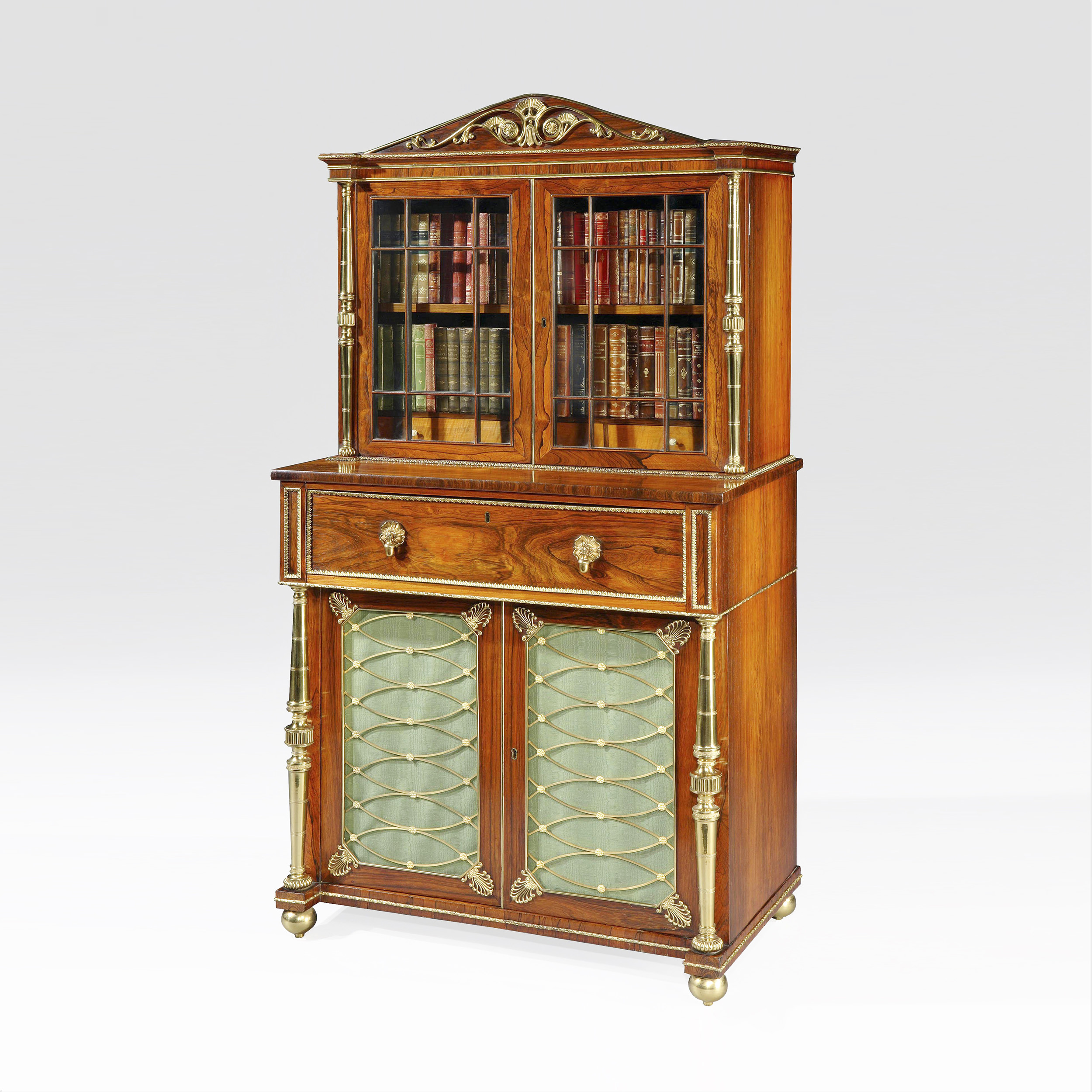
Ref. 7139, A Regency Period Secretaire Bookcase, attributed to John McLean of London, circa 1810. Butchoff Antiques, London.
The Georgian Period was the golden age of household entertainment. Grand homes such as Chiswick House in London were built with the intention to entertain and showcase fine art and contemporary interior decoration. Hosts would have stylish and functional furnishings and objects to entertain guests for hours or even days. Serving tables were and still are very utilitarian pieces for most rooms, or principally entertaining rooms, providing surfaces to hold silver serving platters dressed with food, porcelain ceramics, candelabra, fresh flowers or decorative objects.
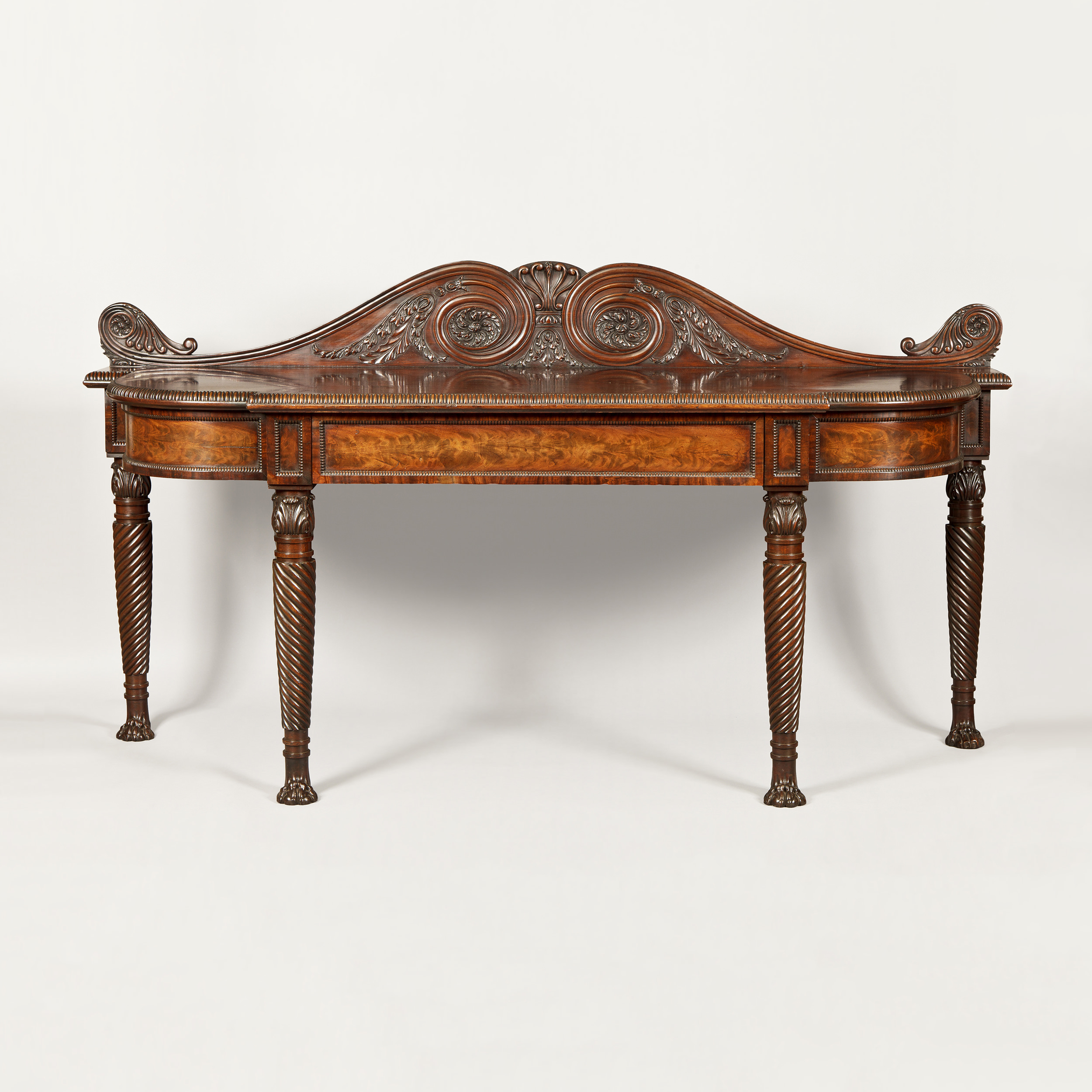
Ref. 7819, A Very Fine Georgian Serving Table of the Regency Period, circa 1820. Butchoff Antiques, London.
Often a decorative wine cooler would sit beneath, filled with ice and beverages, and on either side of the table would sit coordinating cupboards housing plates and silver ware. Such an arrangement would be very similar to this mahogany Georgian Serving Table (ref. 7819) with Chinese inpsired ‘hairy paw’ feet and a decorative serpentine back incorporating well executed Graeco-Roman carvings, with this open top mahogany wine cooler (ref. 5919), and this pair of side cupboards (ref. 8382) adorned with similar carvings.
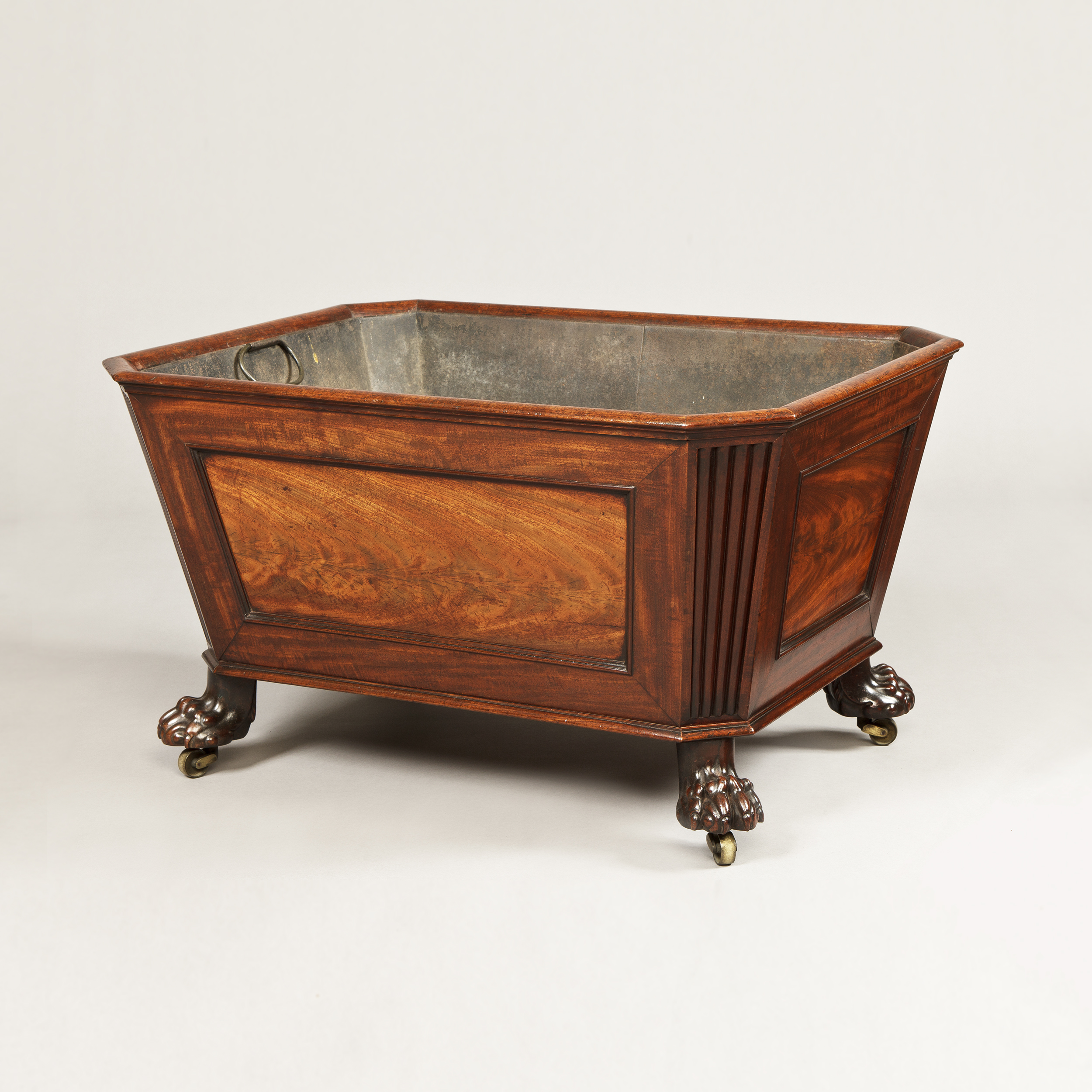
Ref. 5919, A Fine Quality Mahogany Open Top George III Wine Cooler, circa 1815. Previsouly with Butchoff Antiques, London.
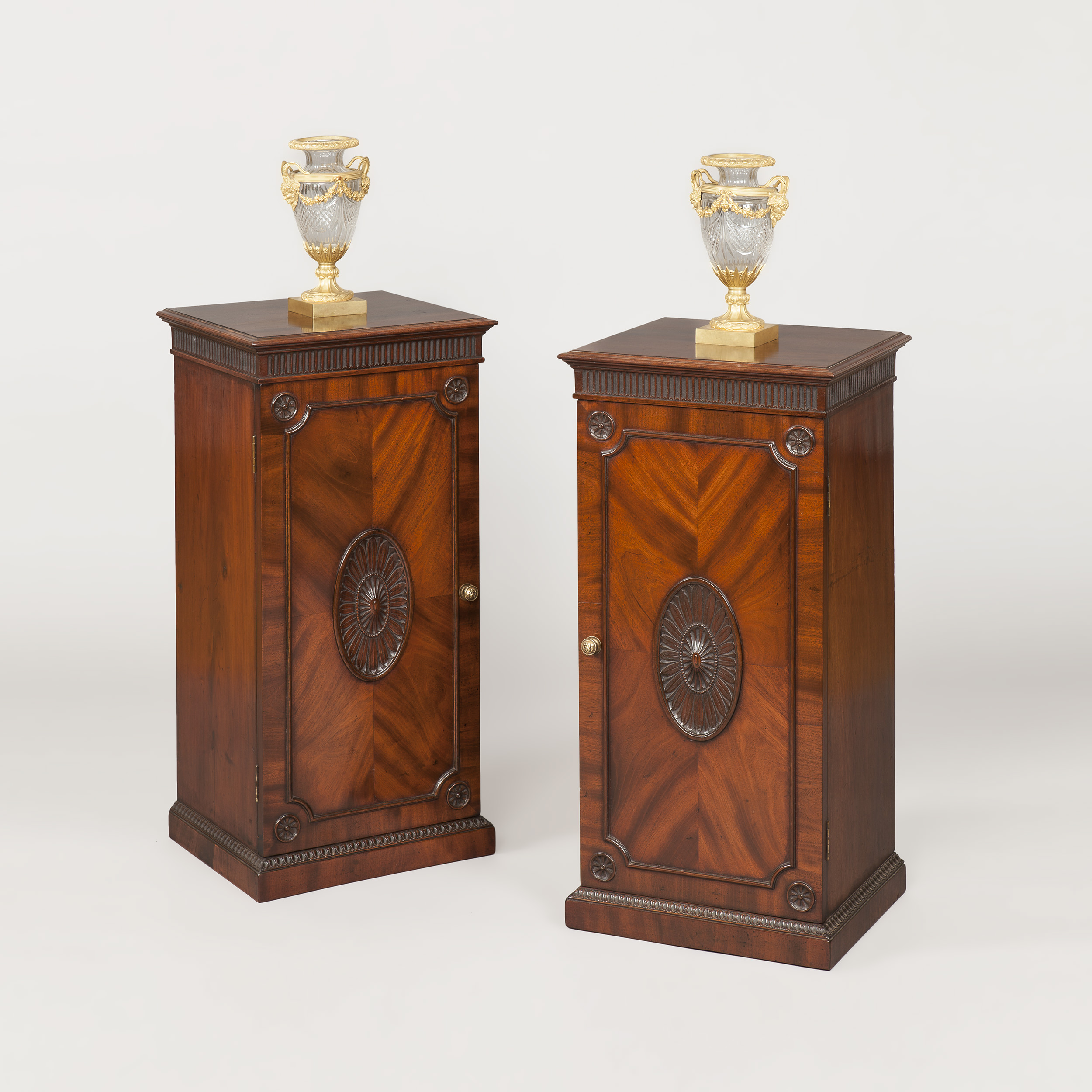
Ref. 8382, A Pair of Georgian Side Cupboards, circa 1820. Previously with Butchoff Antiques, London.
Naturally as the Georgian period came to a close, the style had developed aesthetically over time. Progressing from subtle and fine carved details to more dramatic carvings that would evolve into the Regency Period. An example of the progression is this Pair of Late Georgian Period Armorial Armchairs (ref. 8557). As their grand size, curving and tapering back legs, and robust carvings represent awareness for new designs; yet also keep in the principles of the Georgian period.

Ref. 8557, A Pair of Late Georgian Armorial Armchairs of Important Size, circa 1825. Previously with Butchoff Antiques, London.
The Georgian period is a hallmark for English design and decoration. The taste for Georgian furniture has never necessarily gone too far out of style. By the mid-twentieth century Georgian furniture was revived in both England and America through the interior decorating style renowned as the ‘English Country House Style’, which still continues today to influence contemporary designers and decorating trends.
By Rainier Schraepen
Marquetry is the art of creating intricate pictures and elaborate designs on furniture by skilfully cutting and fitting together thin pieces of domestic and exotic woods, horn, ivory, metal, shell, and other precious materials. Marquetry designs are derived from arabesque and grotesque ornament. While this highly specialized and studied art has roots in ancient times, it was brought to a high level of refinement and popularity in the 17th and 18th centuries in France.

Figure 1. A True Pair of Side Cabinets in the Manner of Andre Charles Boulle (detail). Previously with Butchoff Antiques, London.
André-Charles Boulle’s name is synonymous with the technique known as ‘Boulle’ marquetry. Although not the inventor of the craft - Boulle’s skillful practice of combining contrasting black ebony with gilded bronze and tortoiseshell inlaid with intricate designs of silver-toned pewter and brass is associated as one of the most opulent and expensive form of decoration of furniture. Boulle’s work took two different forms: première partie - pattern in metals with the background in tortoiseshell; and contre partie - pattern in tortoiseshell with the background in metal. Occasionally tortoiseshell is lined on the reverse with a tinted metal foils, such as gold leaf or red, to enhance the naturally spotted patterns of the shell.

Figure 2. A 'Boulle' Marquetry Guéridon. Previously with Butchoff Antiques, London.
Imagine how these pieces of furniture would have looked in the early 18th century. An interior room only lit by daylight and candlelight at night, and how the brass inlay and gilt bronze mounts would have brilliantly flickered amongst the dark. They would have been beacons of light reflecting an impression of grandeur and wealth. The combination of gilt bronze and brass surfaces were revolutionary to the furniture and decoration world.
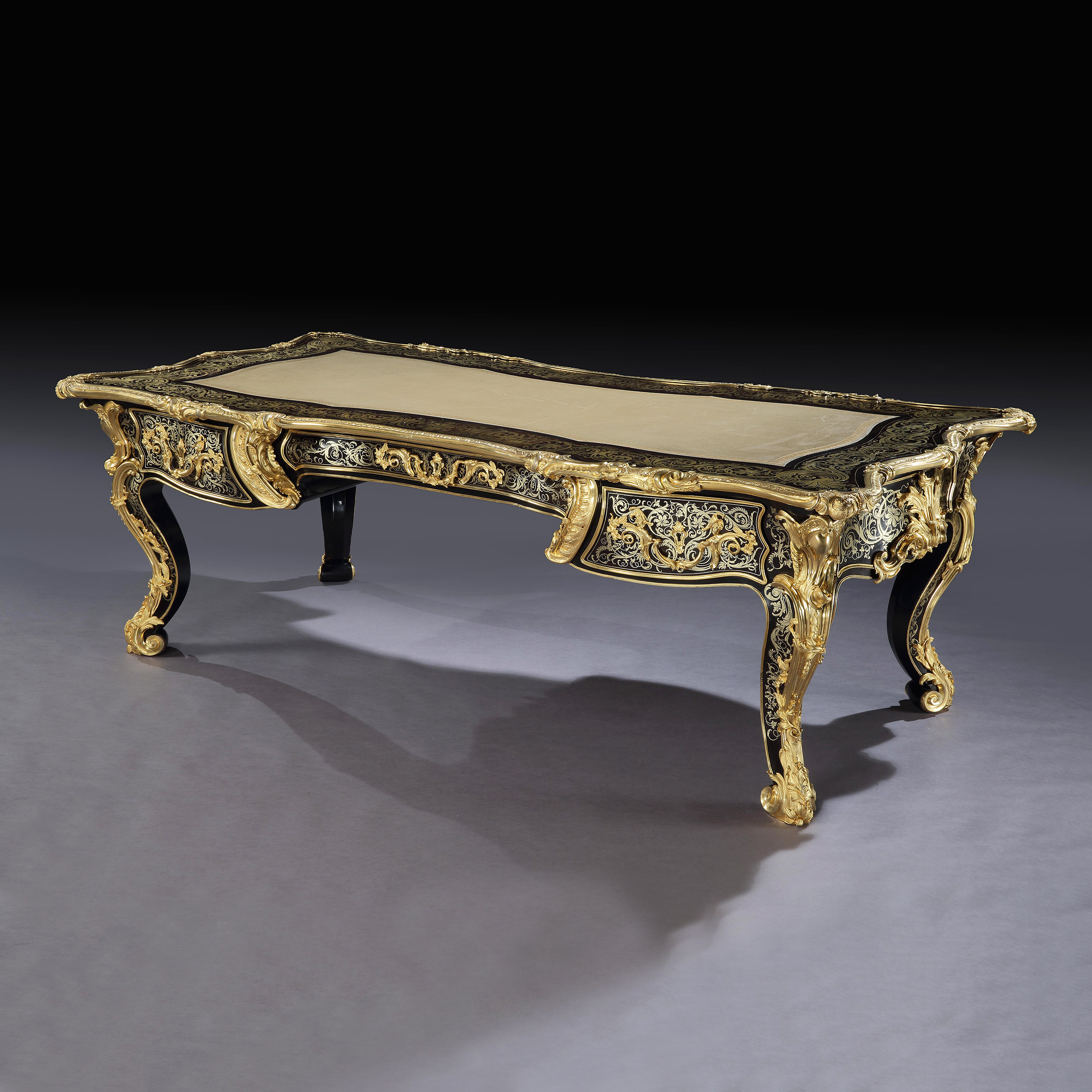
Figure 3. A Bureau Plat in the Louis XIV Manner, by Toms and Luscombe shown at the 1862 International Exhibition. Butchoff Antiques, London.
Over forty-two years, Boulle supplied furniture and interior finishes for King Louis XV and XIV, the Queen, the Grand Dauphin, and many financiers, ministers and important officials throughout Europe. Currently many of Boulle’s attributed works are in some of the finest museums, as well as royal and private collections throughout the world. An authenticated work at auction today would cost quite the fortune, let alone the materials to create a custom-made piece.
Boulle lived from 1642 – 1732 and was received as a Maître Ébéniste in 1666 quickly becoming known as the most skillful artisan in Paris. He was appointed by King XV to ‘Ébéniste du Roi’ in 1672 granting him the royal privilege of lodging in the Palais du Louvre with special permission to work in both bronze and wood. He produced furniture as well as works in gilt bronze, such as chandeliers, wall lights, mounts for furniture, interior decorative details and parquet floors.
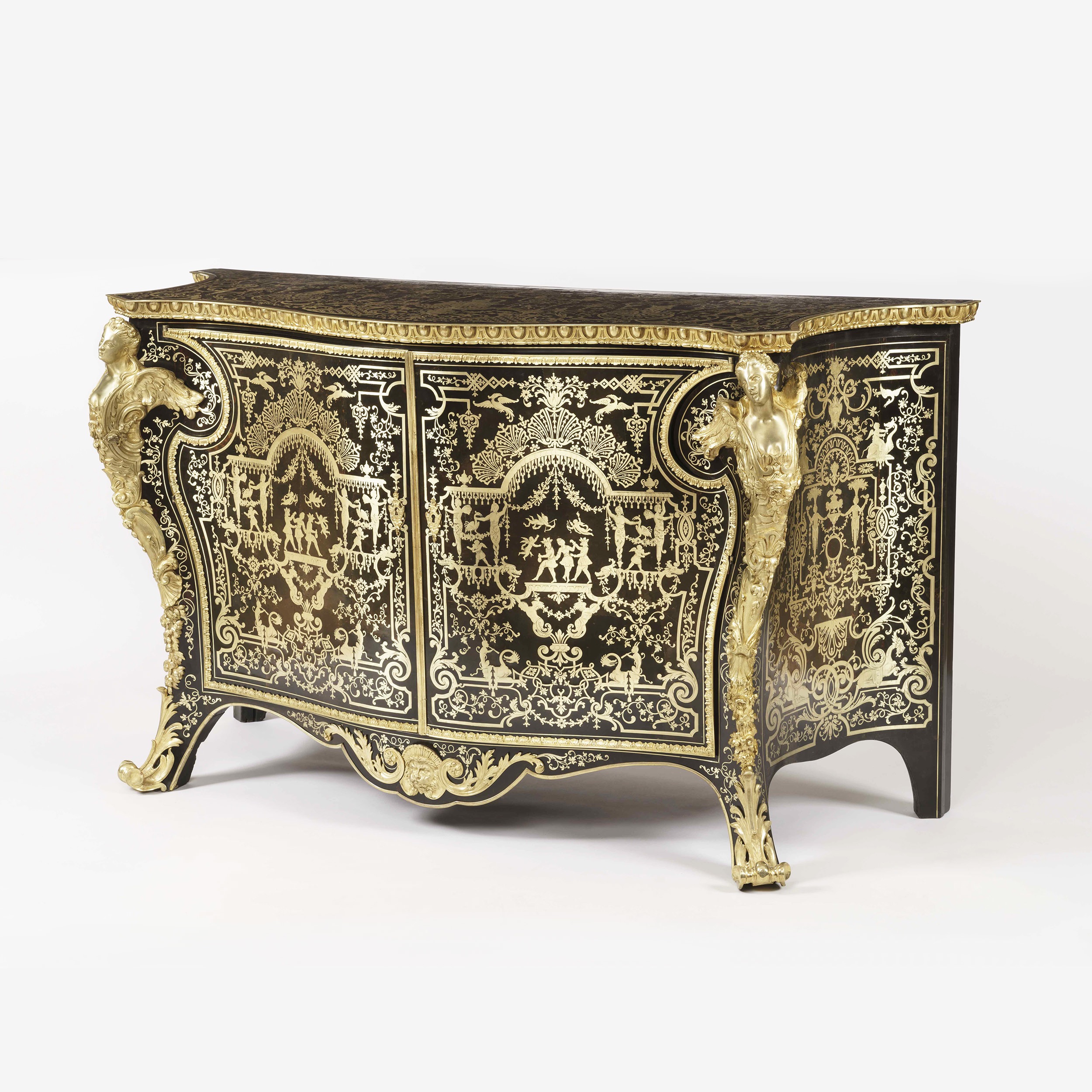
Figure 4. A Fine Commode, by Mellier and Company in the Manner of André-Charles Boulle. Butchoff Antiques, London.
Boulle’s influence in the design and furniture world has lasted for hundreds of years. This has been aided by the circulation of his designs illustrated in books of engravings, published around 1720. Designs included various models of furniture, such as bureau plats, tables, cabinets, pedestals and clocks, offering options for different forms and features, such as assorted leg styles, marquetry decoration, and gilt bronze mounts. An example is of this stylistic influence is the conception of this highly unusual serpentine commode by Mellier (Ref. 9045, fig. 4) constructed in tortoiseshell and brass in premiere-partie Boulle work.
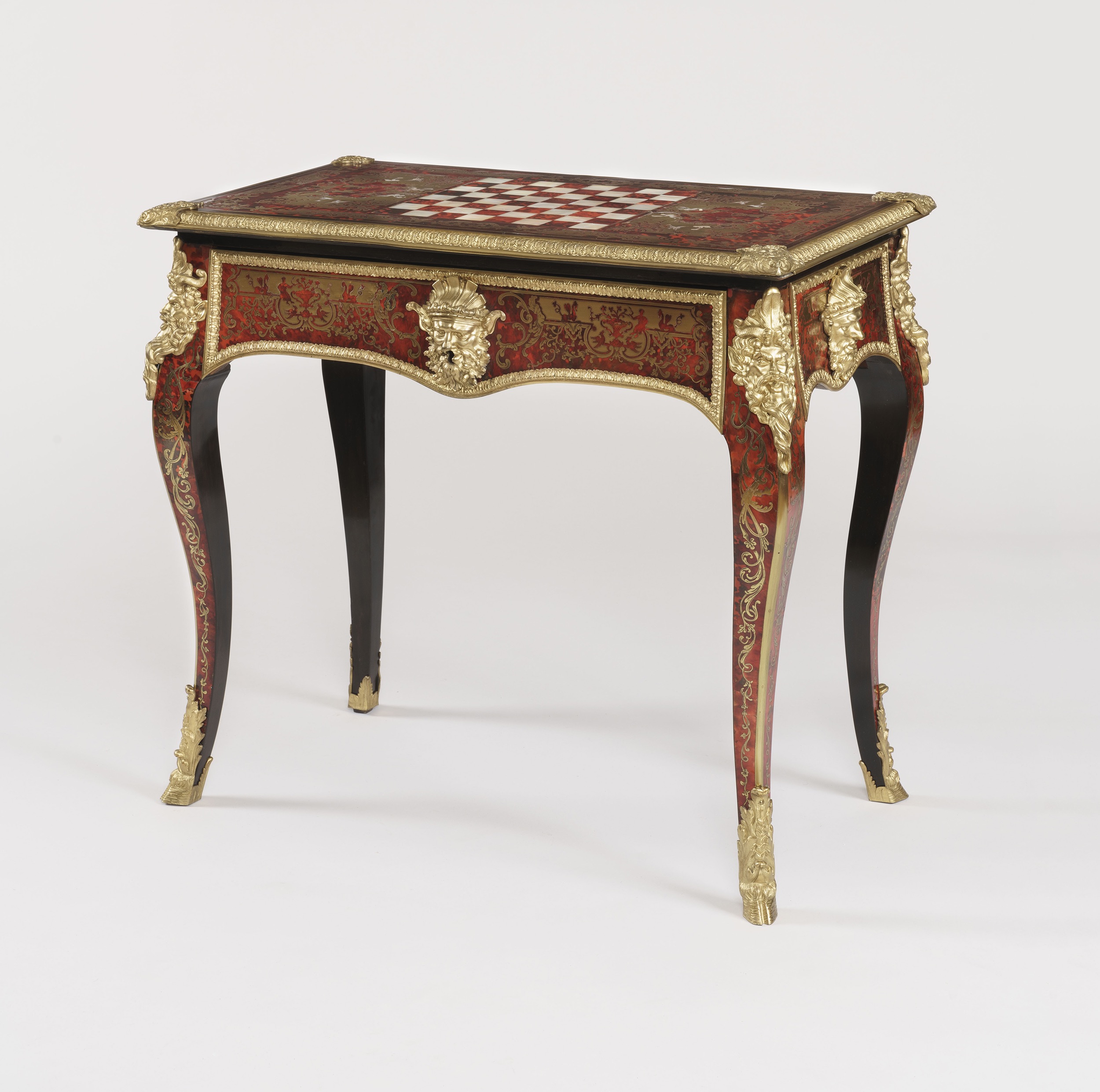
Figure 5. A Fine Games Table of the George IV Period, attributed to Thomas Parker. Butchoff Antiques, London.
Boulle’s ormolu bronze mounts were largely inspired by Classical mythology, such as the Bacchus mask as seen on this bureau plat (fig. 6) symbolically portrayed with grape vine garlands and a crown. The bureau plat demonstrates a beautiful and eye-catching play of contrasting black ebony wood against the gold of gilded bronze and brass inlay. The drawers are enriched with tortoiseshell ground and foliate brass ornamentation and all four corners are mounted with female masks which flow into foliate waterfalls melting into the ebony and brass inlay.
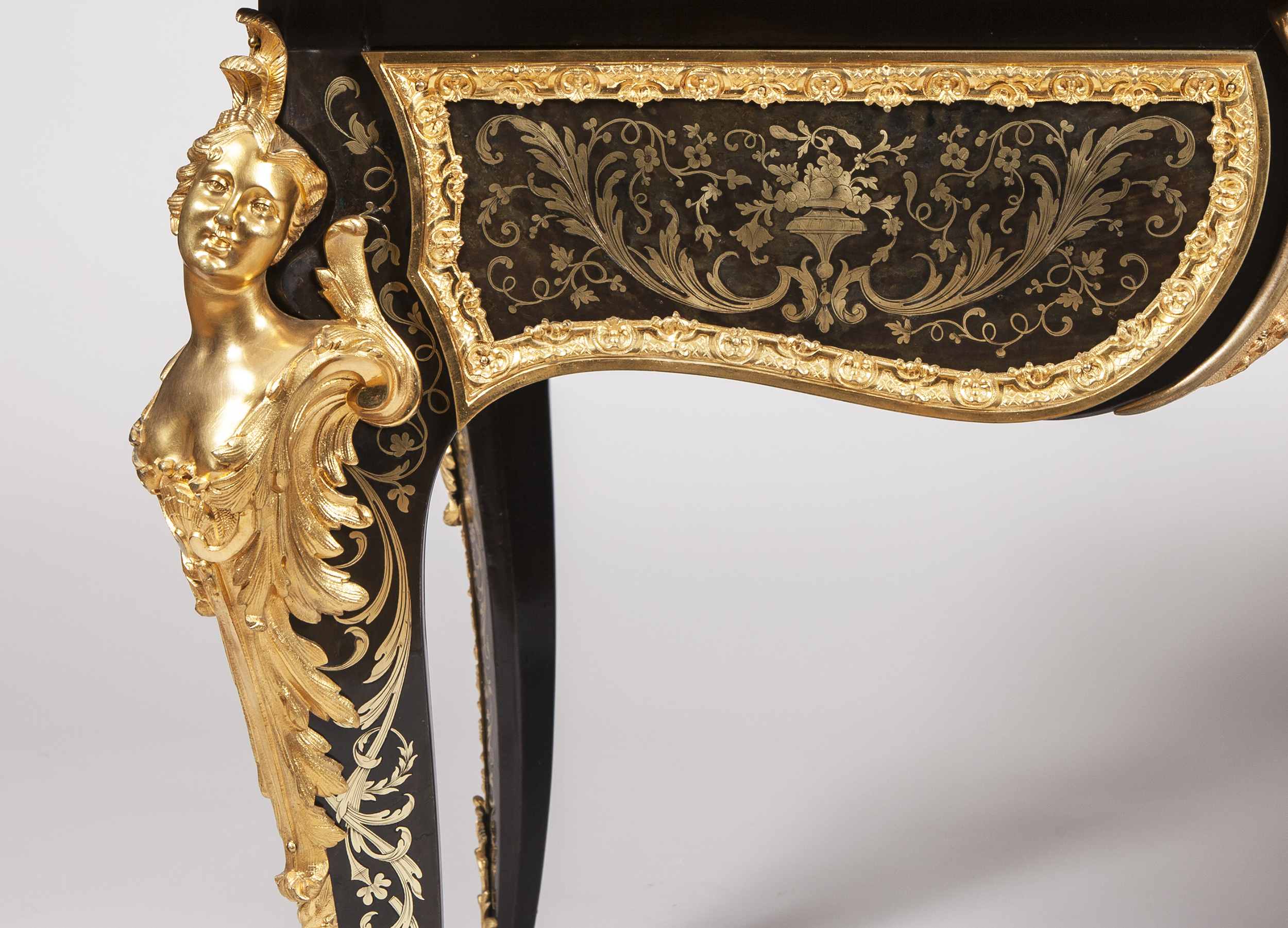
Figure 6. A Fine Bureau Plat in the Manner of André-Charles Boulle. Butchoff Antiques, London.
The inspiration for the Bacchus mount designs likely derive from a medal cabinet attributed to André Charles Boulle dated circa 1710-15 that is now in the J. Paul Getty Museum (84.DA.58) in Los Angeles, California.
by Rainier Schraepen
The Louis XVI style is one of the most prominent and most often imitated styles for furniture and interior decoration. The style, of course, is named after the French King Louis-Auguste who succeeded Louis XIV and Louis XV, both of whom are also associated with their own iconic styles of furniture and interior decoration.
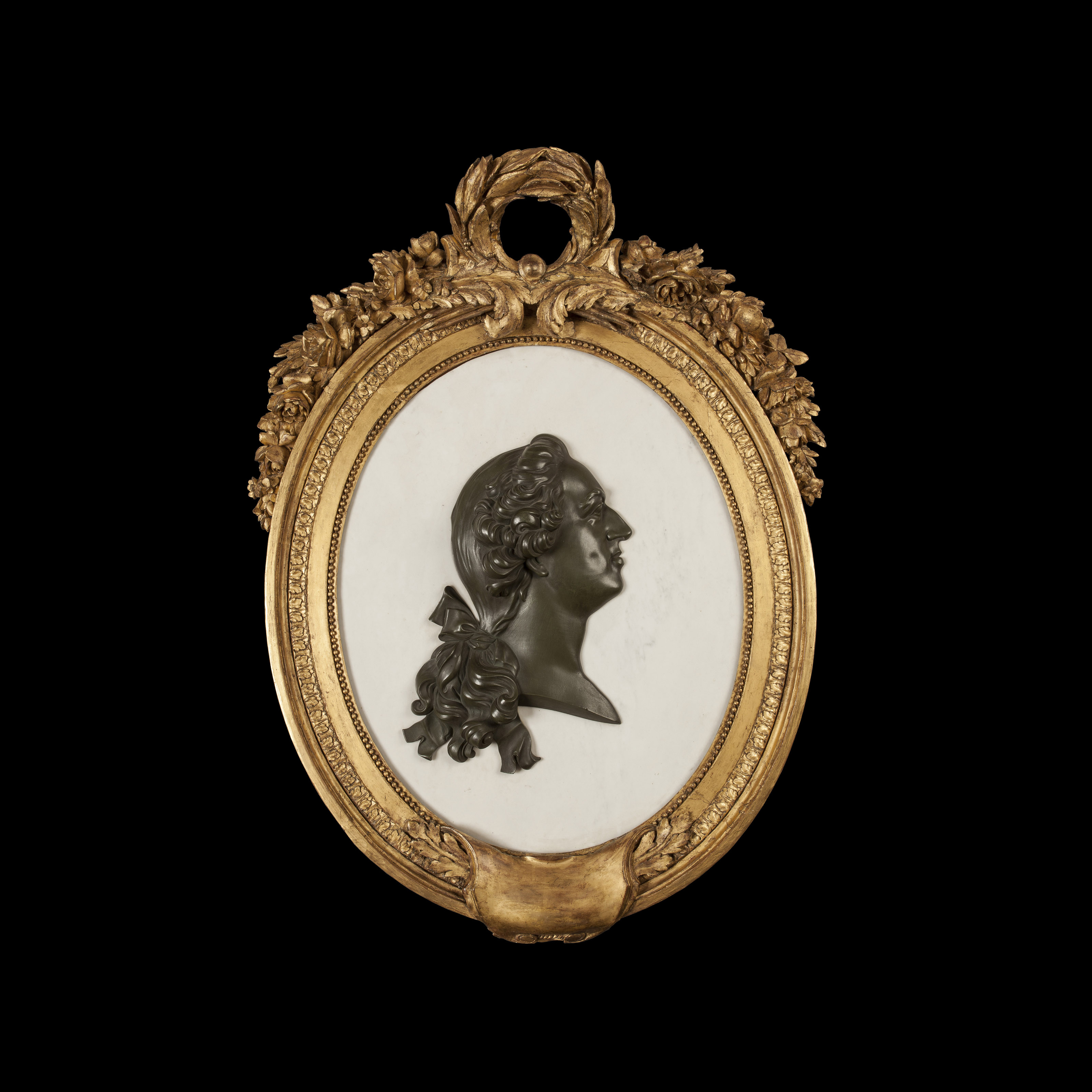
Figure 1. A Marble And Bronze Neo-Classical Portrait Of King Louis XVI. Previously with Butchoff Antiques, London.
The Louis XVI style dates from around 1760 to 1790, and follows the ideals of the English Neoclassical style with which it coincided: a return to the principles and aesthetics of Classical Antiquity. The style is characterized by an emphasis on straight lines and classically inspired decorative motifs.

Figure 2. Grand Salon from the Hôtel de Tessé, Paris , ca. 1768–72.
Made by Nicolas Huyot. On view at The Met Fifth Avenue in Gallery 528.
There is a restraint in decoration compared to the previous Louis XV and Rococo periods, though it is no less opulent or lacking in gilded surfaces. Louis XVI furniture features less floral marquetry, instead showcasing solid veneers of wood framed by straight classically inspired gilt bronze mounts, as shown in this pair of ormolu-mounted plum pudding mahogany occasional tables by Paul Sormani (fig. 3).
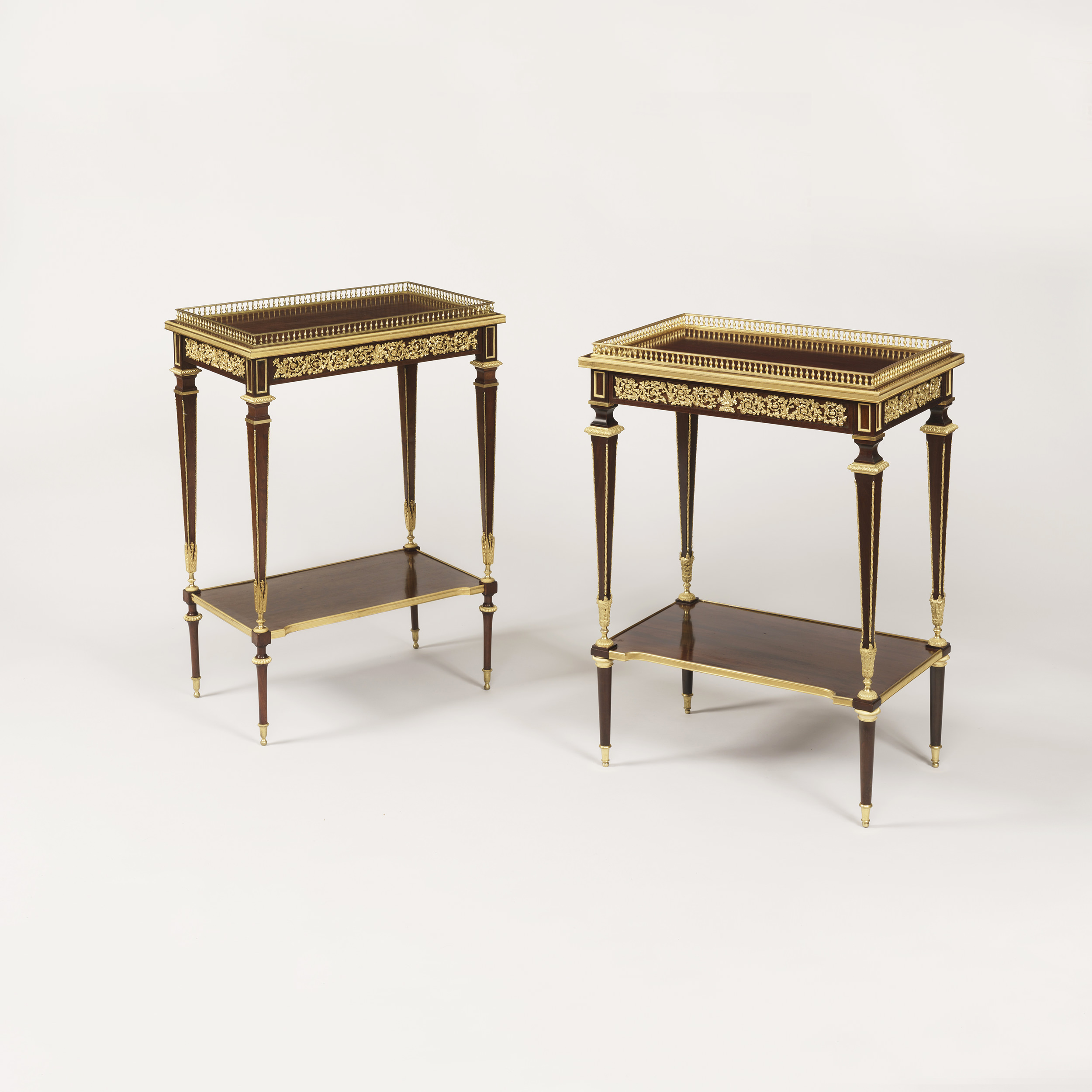
Figure 3. A Matched Pair of Side Tables in the Louis XVIth Manner, by Paul Sormani. Previously with Butchoff Antiques, London.
The burgeoning style was supported and encouraged by the Queen, Marie-Antoinette, who commissioned the decoration and furnishings for her many apartments at the royal residences of Versailles (fig. 4), Saint-Cloud, Petit Trianon, and Grand Trianon in this latest fashion.
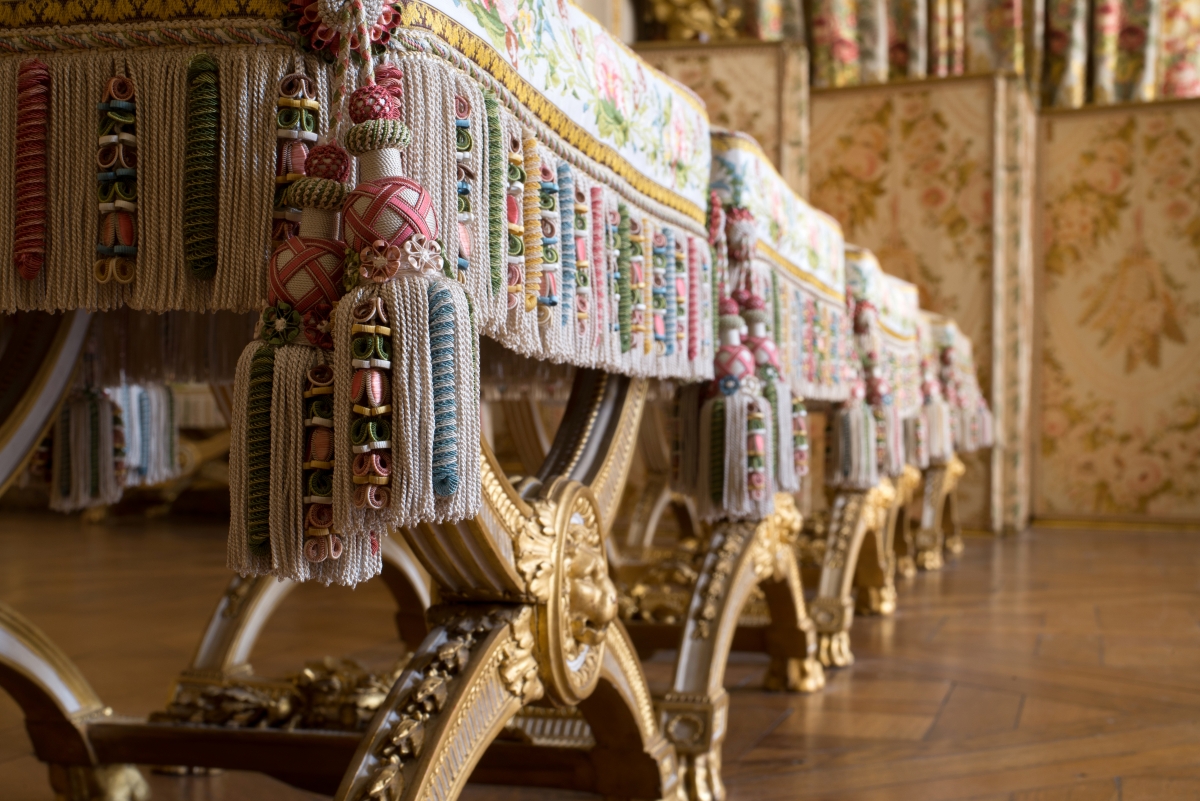
Figure 4. Louis XVI's Clothes Cabinet, Château de Versailles. Courtesy of Palace of Versailles.
The French Revolution (1789-1799) forced hundreds of millions worth of possessions and property of the Crown to be sold, making many of these pieces available on the art market. Many items were destroyed, while others have trickled down into today's galleries and museums throughout the world, such as the Louvre, the Metropolitan Museum of Art, the Victoria and Albert Musuem, and the Wallace Collection.
The importance, beauty, and rarity of these furnishings and objects d’art became increasingly widely recognised, as an international crowd of wealthy individuals and members of the aristocracy began to enthusiastically collect them. In the second-half of the nineteenth century, many faithful copies or similar models were commissioned for private collections, including many of the pieces pictured in this article.
Riesener supplied furniture of incredible luxury, demonstrating his ingenious sense of design and meticulous craftsmanship. Pieces included materials of imported Japanese lacquer with gilt, mother-of-pearl, and richly gilded ormolu mounts. A commode now at the Metropolitan Museum of Art was made by Riesener in 1783 (20.155.12) for Marie Antoinette’s Cabinet Interieur at Versailles, likely inspired this model by Henry Dasson (fig. 5), which is adorned with similarly finely cast gilt bronze mounts and imported black and gilt dusted Japanese panels.
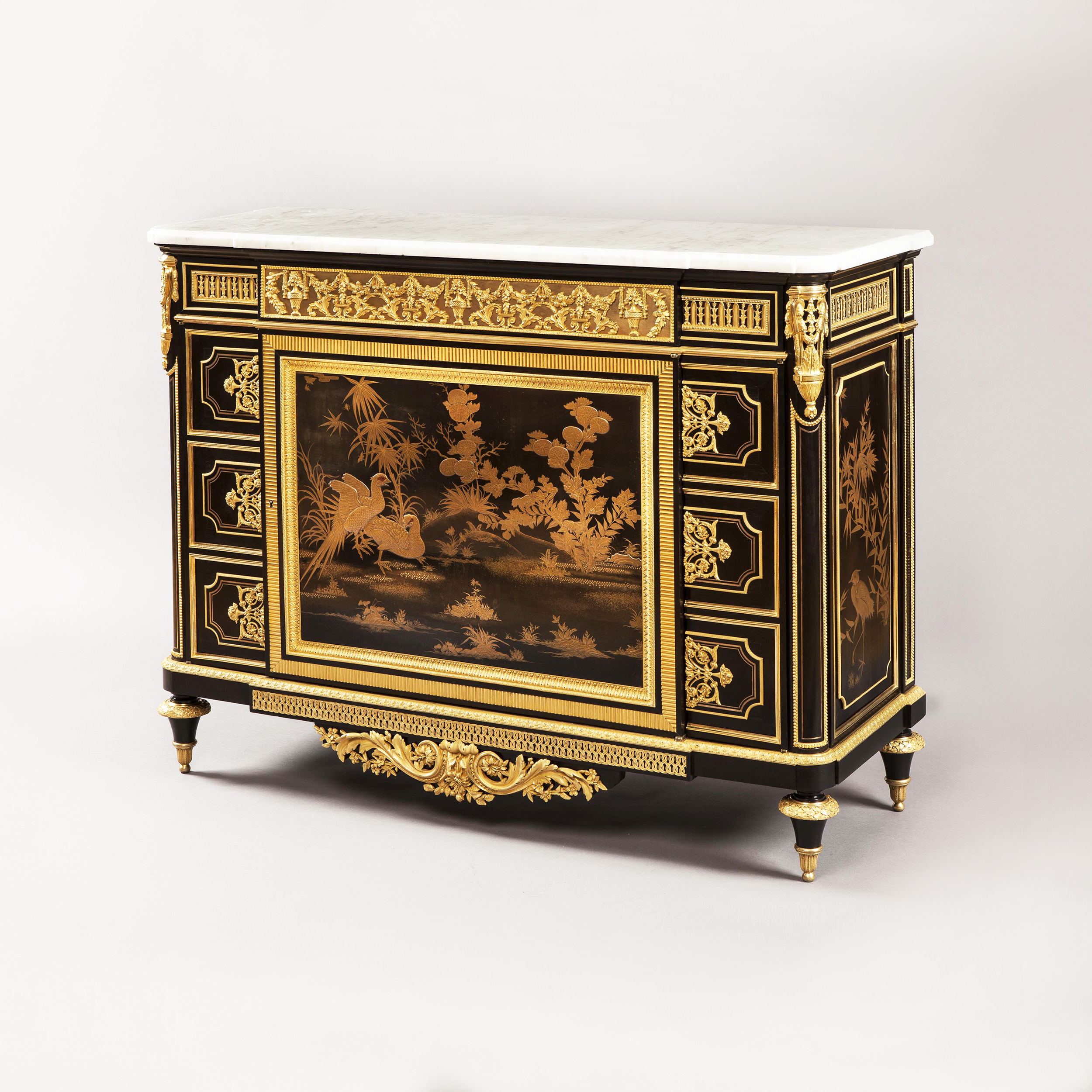
Figure 5. A Magnificent Louis XVI Style Commode, firmly attributed to Henry Dasson of Paris. Previously with Butchoff Antiques, London.
This bespoke English secretaire (fig. 6) was made after a model by Riesener, circa 1783, delivered for Marie-Antoinette’s private study at the château of Versailles, and which is now part of the Wallace Collection, London (F303). The central bronze mount on the drop-front depicts a classically inspired allegorical scene of ‘A Sacrifice of Love’, which was likely intended for the Queen’s amusement.

Figure 6. An Exceptionally Rare Secrétaire, after the J.H. Riesener example in The Wallace Collection. Previously with Butchoff Antiques, London.
Adam Weisweiler (1744–1820) is notable for his designs and selling his works works through merchants, such as Daguerre, who had royal ties, and fellow ébenistes like Riesener.
He is especially well known for his trademark-interlaced stretcher, demonstrated on this fine escritoire after a design by Weisweiler (fig. 7). The significance of this piece is that it is similar or based upon the design of a secretaire attributed to Weisweiler, circa 1790, that is believed to have been one of the last pieces delivered by Daguerre for Marie-Antoinette at Versailles before the Revolution, and is now in the collection of the Metropolitan Museum of Art (58.75.57).

Figure 7. A Fine Escritoire, after a Design by Adam Weisweiler. Previously with Butchoff Antiques, London.
Giltwood chairs and settees were principal pieces of decoration and function in Louis XVI interiors, like this pair of giltwood armchairs (fig. 8). Chair frames were hand-carved out of wood, such as fruitwood, beech or walnut, and sometimes incorporated gesso, and adorned with decorative motifs of florals, foliates, garlands and classical figures. Upholstery was typically of hand-sewn silks in floral or classical designs, or damask or tapestry in colours of creams and pastel colours. Seating was either pushed against a wall or in the center of the room, likely accompanied by elegant and classically inspired side tables (fig. 9), conducive to conversation.

Figure 8. A Pair of Fauteuils in the Louis XVI Manner. Butchoff Antiques, London.
Although the reign of Louis XVI and Marie-Antoinette did not last, the associated style of decoration and furnishings of this period have been long regarded and admired, and artifacts of this prominent aesthetic will continue to be highly valued and collected.
![A Fine Guéridon in the Manner of Adam Weisweiler by Henry Dasson Constructed in Brocatelle d'Espagne marble and mahogany, with finely cast and chased gilt bronze mounts; the top tier of circular form supported on cluster legs of bamboo shape in the typical manner of Weisweiler. The columns joined by a concave-shaped lower tier supported by flared feet dressed with gilt bronze sabots. This celebrated model of gueridon exemplifies the height of taste at the end of the eighteenth century, it was given by Madame du Barry (1743-1793) to the duc de Brissac, delivered by Lignereux and Daguerre. Daguerre's inventory describes a table of corresponding description "Une petite table ronde forme de guéridon en racine de bois d'acajou poli sur trois pieds doubles en bronze doré façon de bambous avec entrejambe à tablettes et camé de porcelaine ornant la tablette supérieure prisée trois cent francs." (Segoura, Maurice, and Patricia Lemonnier. Weisweiler. Paris: Monelle Hayot, 1983.) Henry Dasson became renowned in the nineteenth century for his furniture based on historical designs, often incorporating stylistic elements created by Weisweiler (see Payne, Christopher. Paris Furniture: The Luxury Market of the 19th Century. [S.L.]: Editions D'art Monelle, 2018.). Christopher Payne maintains that "His [Dasson's] best work must be the combinations of elements from Riesener and Weisweiler in a modernised Louis XVI manner" (p. 315) as seen in the present gueridon. Signed and dated 'Henry Dasson. 1878.' French, 1878 Dimensions: H: 26 in / 65 cm | Dia: 15 in / 37 cm](https://images.butchoff.com/magallery/ButchoffMedia/BlogDescription/1922019T165331.26.jpg)
Figure 9. A Fine Guéridon in the Manner of Adam Weisweiler, by Henry Dasson. Previously with Butchoff Antiques, London.
by Rainier Schraepen

 Vip access
Vip access

 Favourites
Favourites







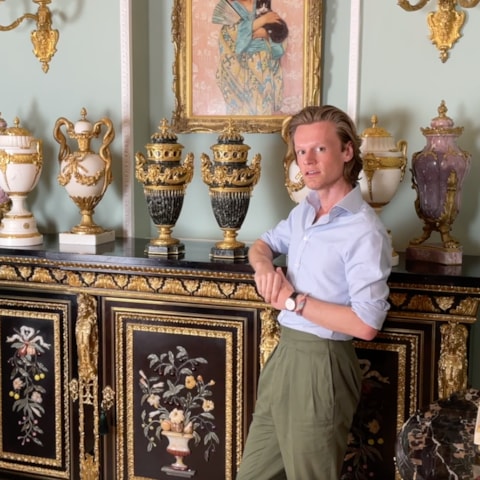


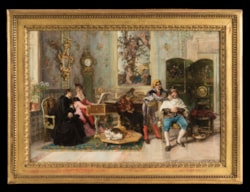




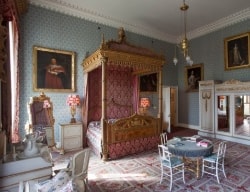

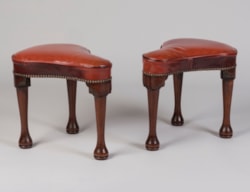


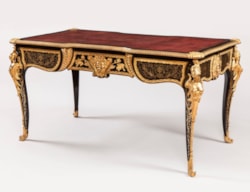
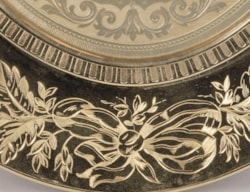
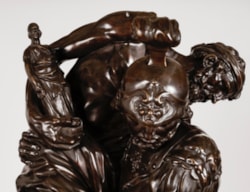
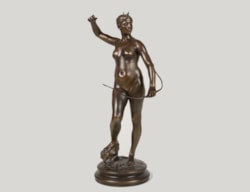

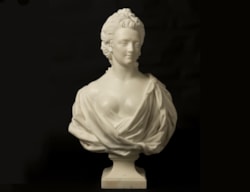

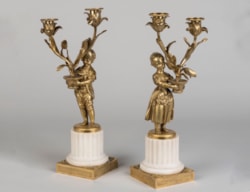
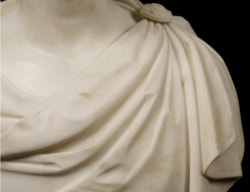
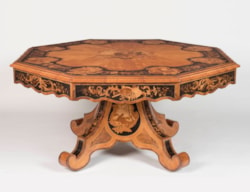
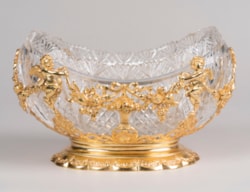
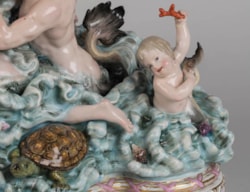


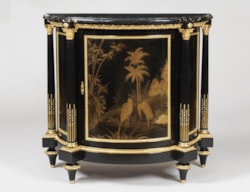
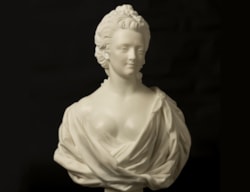
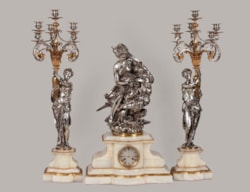
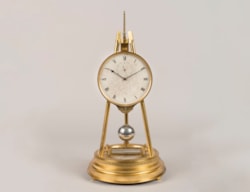

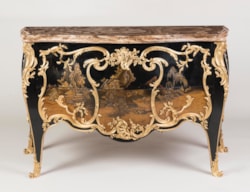

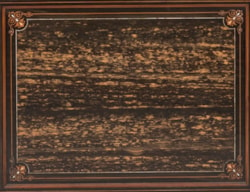
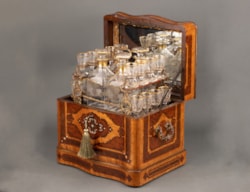
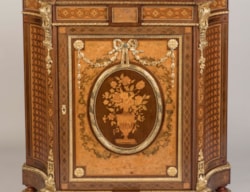

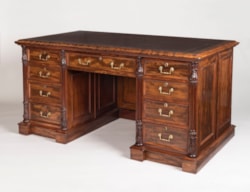
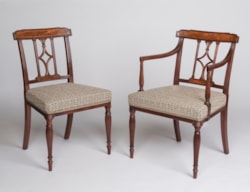
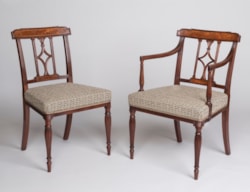
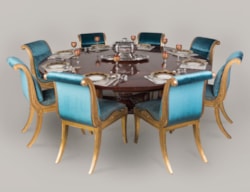
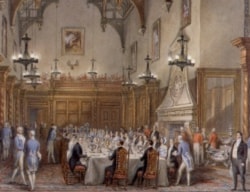
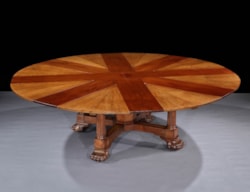

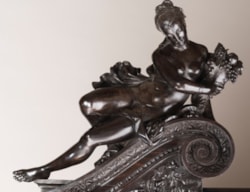
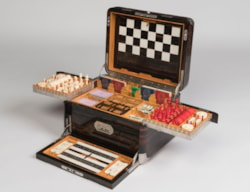


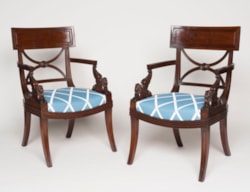
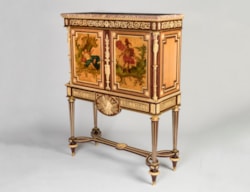
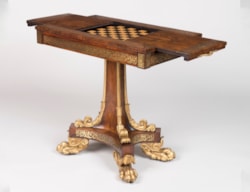
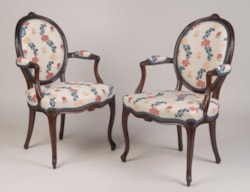

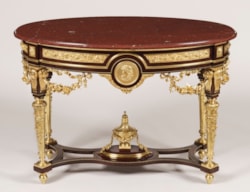

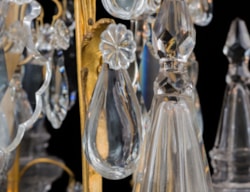
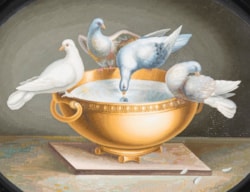

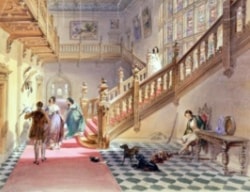

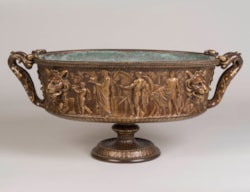
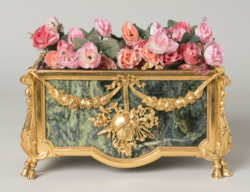
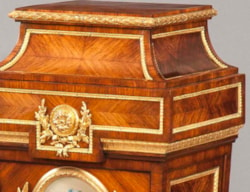
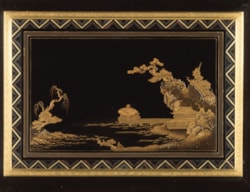
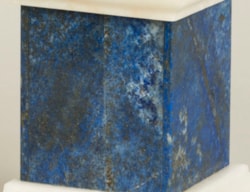
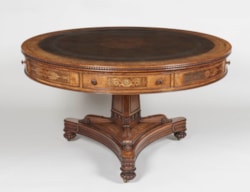
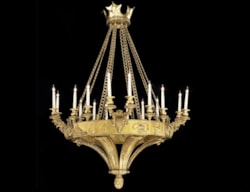

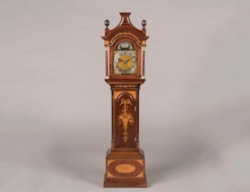

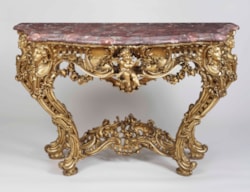
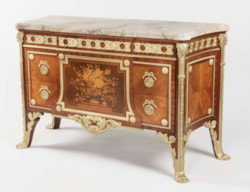
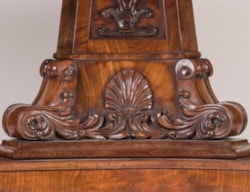
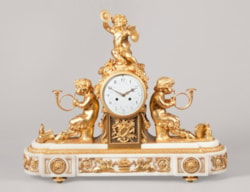
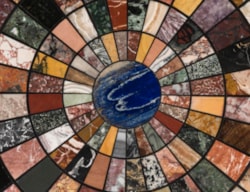
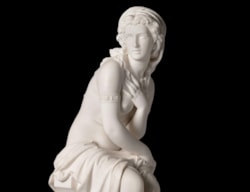


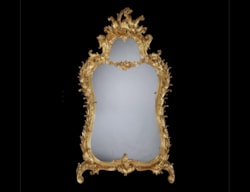

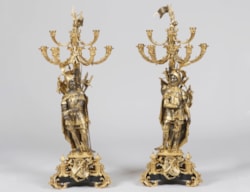
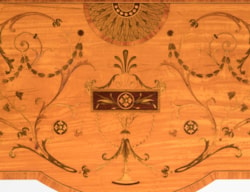

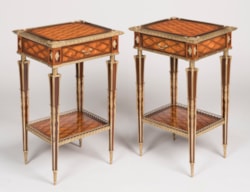
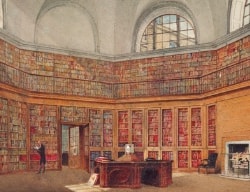
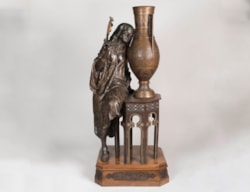
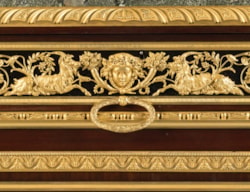

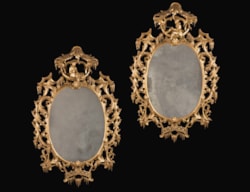

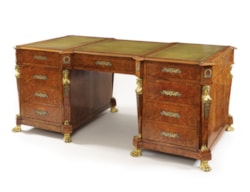
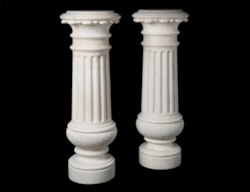
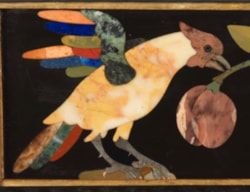
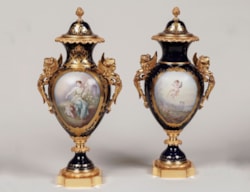
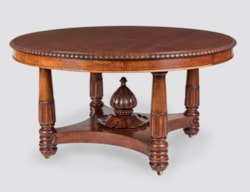
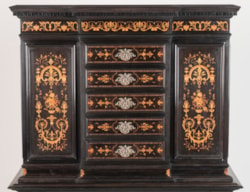
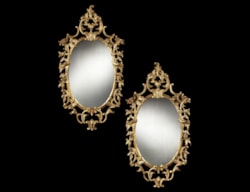

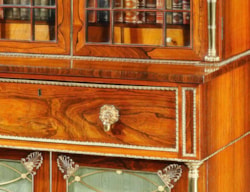
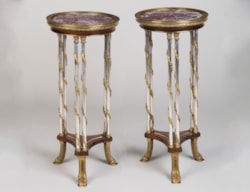
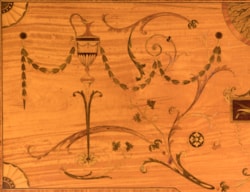

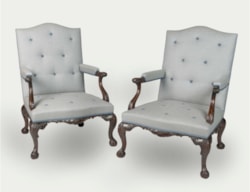
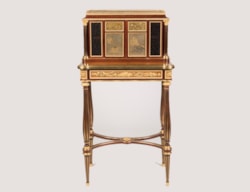
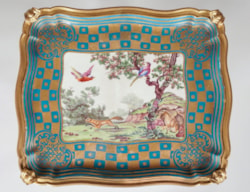
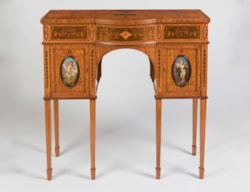
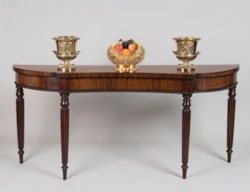
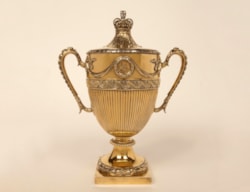
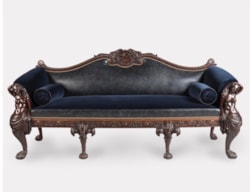
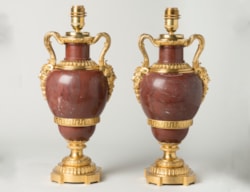

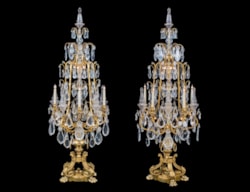

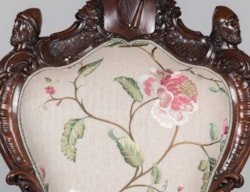
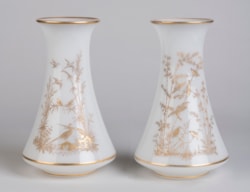


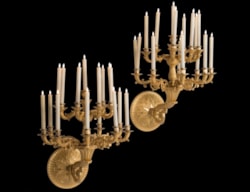
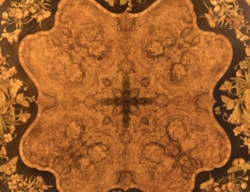
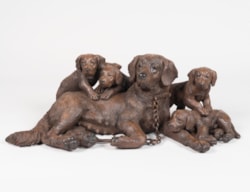



 Read More
Read More

